Personal and Professional Development
VerifiedAdded on 2023/01/16
|21
|5271
|94
AI Summary
Contribute Materials
Your contribution can guide someone’s learning journey. Share your
documents today.
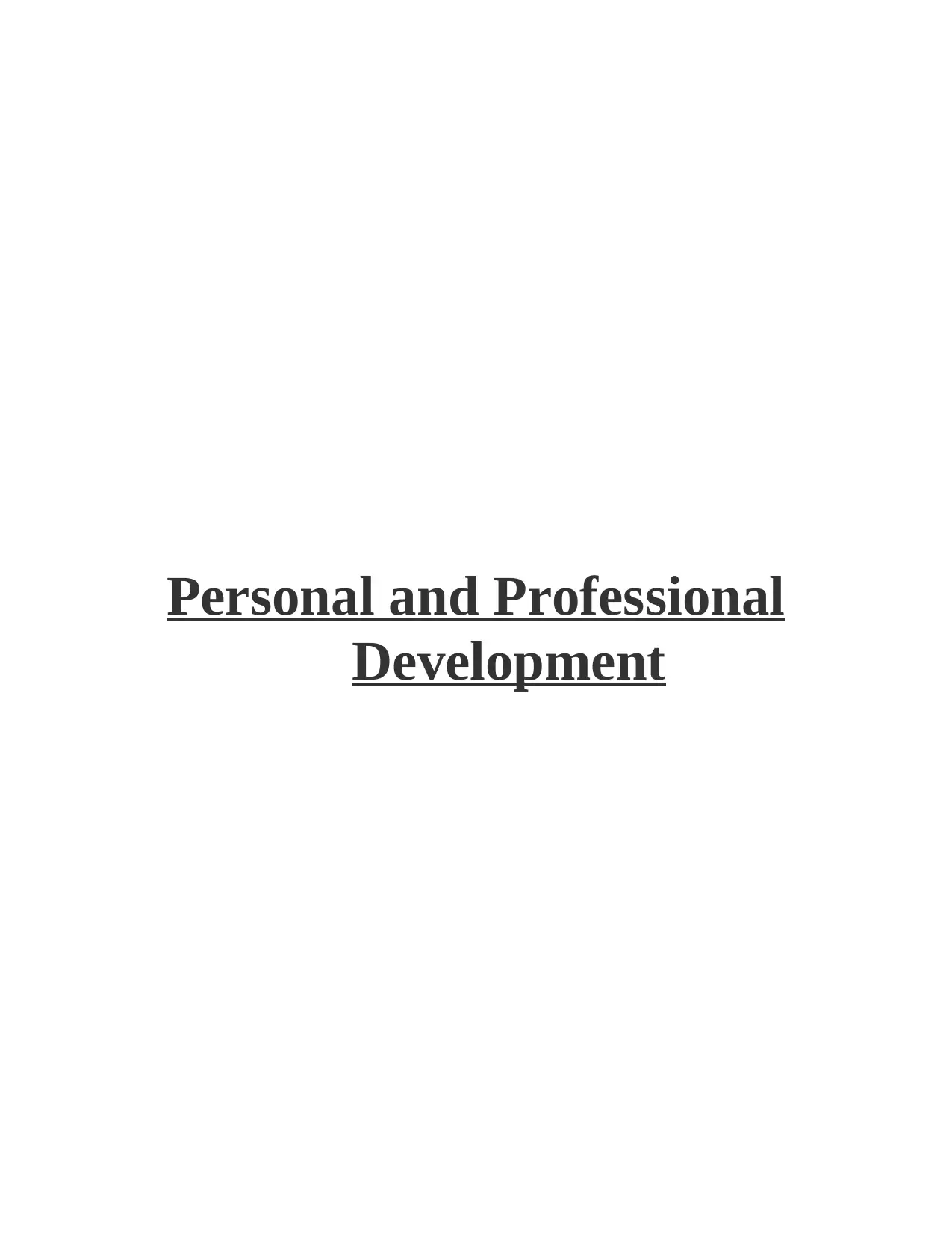
Personal and Professional
Development
Development
Secure Best Marks with AI Grader
Need help grading? Try our AI Grader for instant feedback on your assignments.
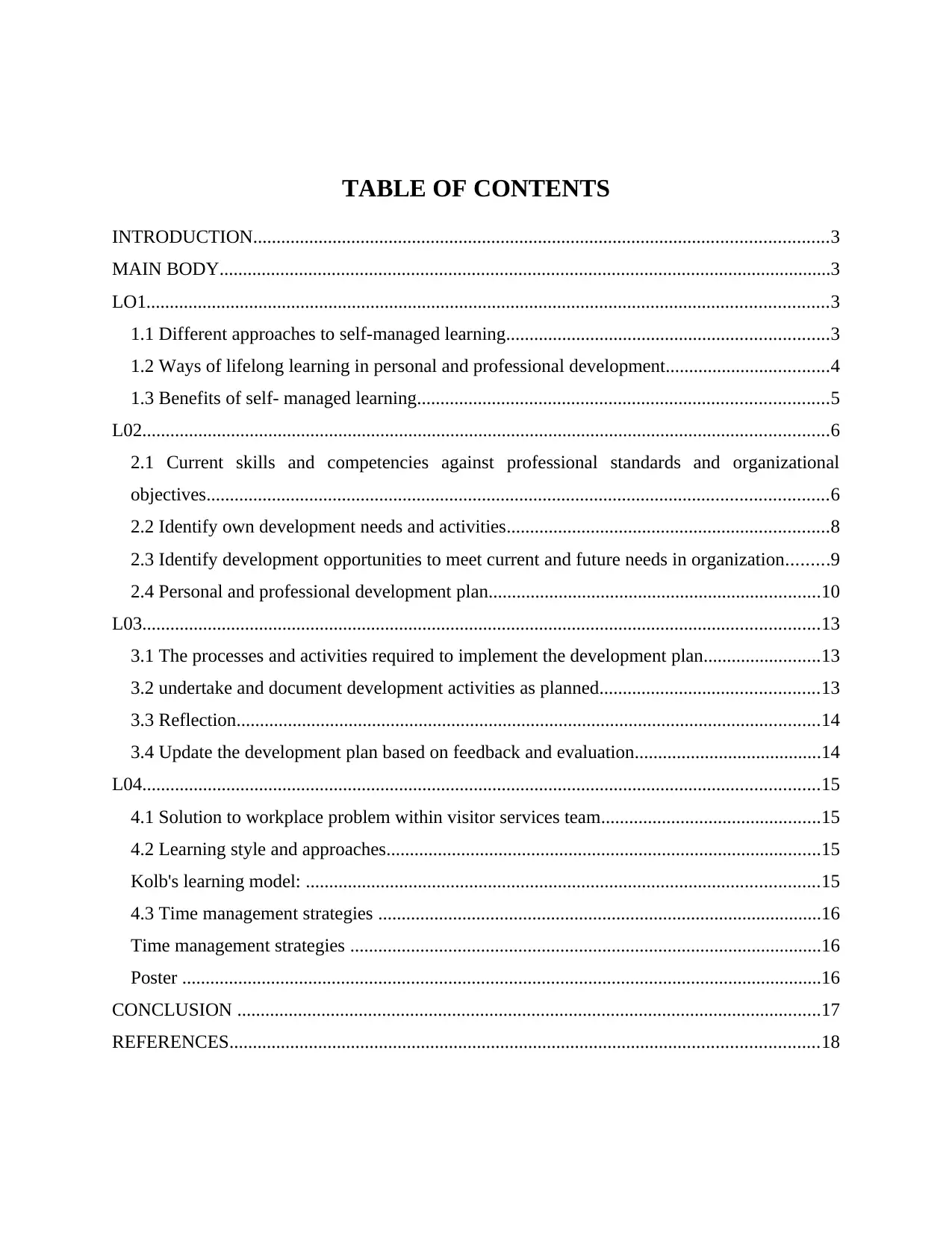
TABLE OF CONTENTS
INTRODUCTION...........................................................................................................................3
MAIN BODY...................................................................................................................................3
LO1..................................................................................................................................................3
1.1 Different approaches to self-managed learning.....................................................................3
1.2 Ways of lifelong learning in personal and professional development...................................4
1.3 Benefits of self- managed learning........................................................................................5
L02...................................................................................................................................................6
2.1 Current skills and competencies against professional standards and organizational
objectives.....................................................................................................................................6
2.2 Identify own development needs and activities.....................................................................8
2.3 Identify development opportunities to meet current and future needs in organization.........9
2.4 Personal and professional development plan.......................................................................10
L03.................................................................................................................................................13
3.1 The processes and activities required to implement the development plan.........................13
3.2 undertake and document development activities as planned...............................................13
3.3 Reflection.............................................................................................................................14
3.4 Update the development plan based on feedback and evaluation........................................14
L04.................................................................................................................................................15
4.1 Solution to workplace problem within visitor services team...............................................15
4.2 Learning style and approaches.............................................................................................15
Kolb's learning model: ..............................................................................................................15
4.3 Time management strategies ...............................................................................................16
Time management strategies .....................................................................................................16
Poster .........................................................................................................................................16
CONCLUSION .............................................................................................................................17
REFERENCES..............................................................................................................................18
INTRODUCTION...........................................................................................................................3
MAIN BODY...................................................................................................................................3
LO1..................................................................................................................................................3
1.1 Different approaches to self-managed learning.....................................................................3
1.2 Ways of lifelong learning in personal and professional development...................................4
1.3 Benefits of self- managed learning........................................................................................5
L02...................................................................................................................................................6
2.1 Current skills and competencies against professional standards and organizational
objectives.....................................................................................................................................6
2.2 Identify own development needs and activities.....................................................................8
2.3 Identify development opportunities to meet current and future needs in organization.........9
2.4 Personal and professional development plan.......................................................................10
L03.................................................................................................................................................13
3.1 The processes and activities required to implement the development plan.........................13
3.2 undertake and document development activities as planned...............................................13
3.3 Reflection.............................................................................................................................14
3.4 Update the development plan based on feedback and evaluation........................................14
L04.................................................................................................................................................15
4.1 Solution to workplace problem within visitor services team...............................................15
4.2 Learning style and approaches.............................................................................................15
Kolb's learning model: ..............................................................................................................15
4.3 Time management strategies ...............................................................................................16
Time management strategies .....................................................................................................16
Poster .........................................................................................................................................16
CONCLUSION .............................................................................................................................17
REFERENCES..............................................................................................................................18
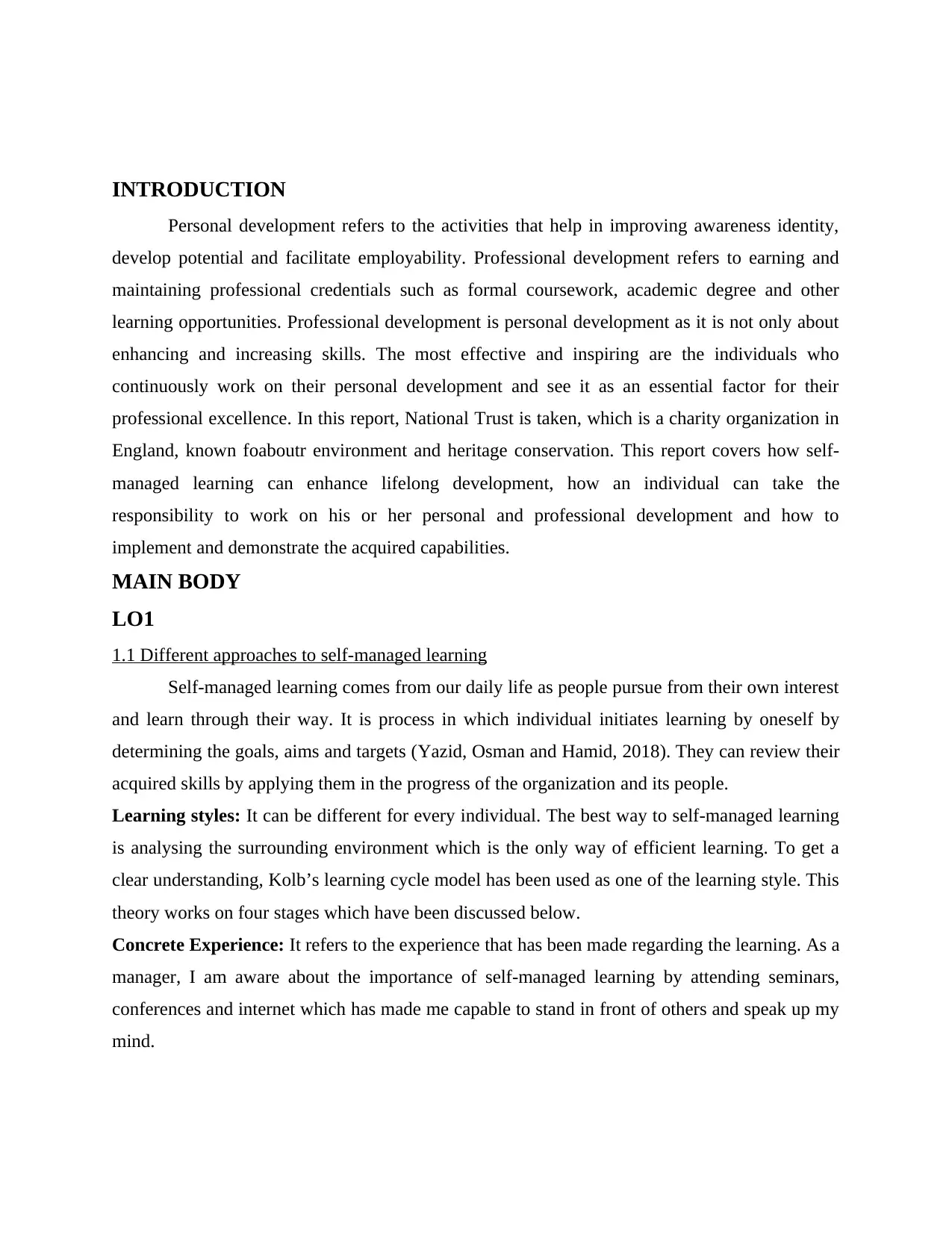
INTRODUCTION
Personal development refers to the activities that help in improving awareness identity,
develop potential and facilitate employability. Professional development refers to earning and
maintaining professional credentials such as formal coursework, academic degree and other
learning opportunities. Professional development is personal development as it is not only about
enhancing and increasing skills. The most effective and inspiring are the individuals who
continuously work on their personal development and see it as an essential factor for their
professional excellence. In this report, National Trust is taken, which is a charity organization in
England, known foaboutr environment and heritage conservation. This report covers how self-
managed learning can enhance lifelong development, how an individual can take the
responsibility to work on his or her personal and professional development and how to
implement and demonstrate the acquired capabilities.
MAIN BODY
LO1
1.1 Different approaches to self-managed learning
Self-managed learning comes from our daily life as people pursue from their own interest
and learn through their way. It is process in which individual initiates learning by oneself by
determining the goals, aims and targets (Yazid, Osman and Hamid, 2018). They can review their
acquired skills by applying them in the progress of the organization and its people.
Learning styles: It can be different for every individual. The best way to self-managed learning
is analysing the surrounding environment which is the only way of efficient learning. To get a
clear understanding, Kolb’s learning cycle model has been used as one of the learning style. This
theory works on four stages which have been discussed below.
Concrete Experience: It refers to the experience that has been made regarding the learning. As a
manager, I am aware about the importance of self-managed learning by attending seminars,
conferences and internet which has made me capable to stand in front of others and speak up my
mind.
Personal development refers to the activities that help in improving awareness identity,
develop potential and facilitate employability. Professional development refers to earning and
maintaining professional credentials such as formal coursework, academic degree and other
learning opportunities. Professional development is personal development as it is not only about
enhancing and increasing skills. The most effective and inspiring are the individuals who
continuously work on their personal development and see it as an essential factor for their
professional excellence. In this report, National Trust is taken, which is a charity organization in
England, known foaboutr environment and heritage conservation. This report covers how self-
managed learning can enhance lifelong development, how an individual can take the
responsibility to work on his or her personal and professional development and how to
implement and demonstrate the acquired capabilities.
MAIN BODY
LO1
1.1 Different approaches to self-managed learning
Self-managed learning comes from our daily life as people pursue from their own interest
and learn through their way. It is process in which individual initiates learning by oneself by
determining the goals, aims and targets (Yazid, Osman and Hamid, 2018). They can review their
acquired skills by applying them in the progress of the organization and its people.
Learning styles: It can be different for every individual. The best way to self-managed learning
is analysing the surrounding environment which is the only way of efficient learning. To get a
clear understanding, Kolb’s learning cycle model has been used as one of the learning style. This
theory works on four stages which have been discussed below.
Concrete Experience: It refers to the experience that has been made regarding the learning. As a
manager, I am aware about the importance of self-managed learning by attending seminars,
conferences and internet which has made me capable to stand in front of others and speak up my
mind.
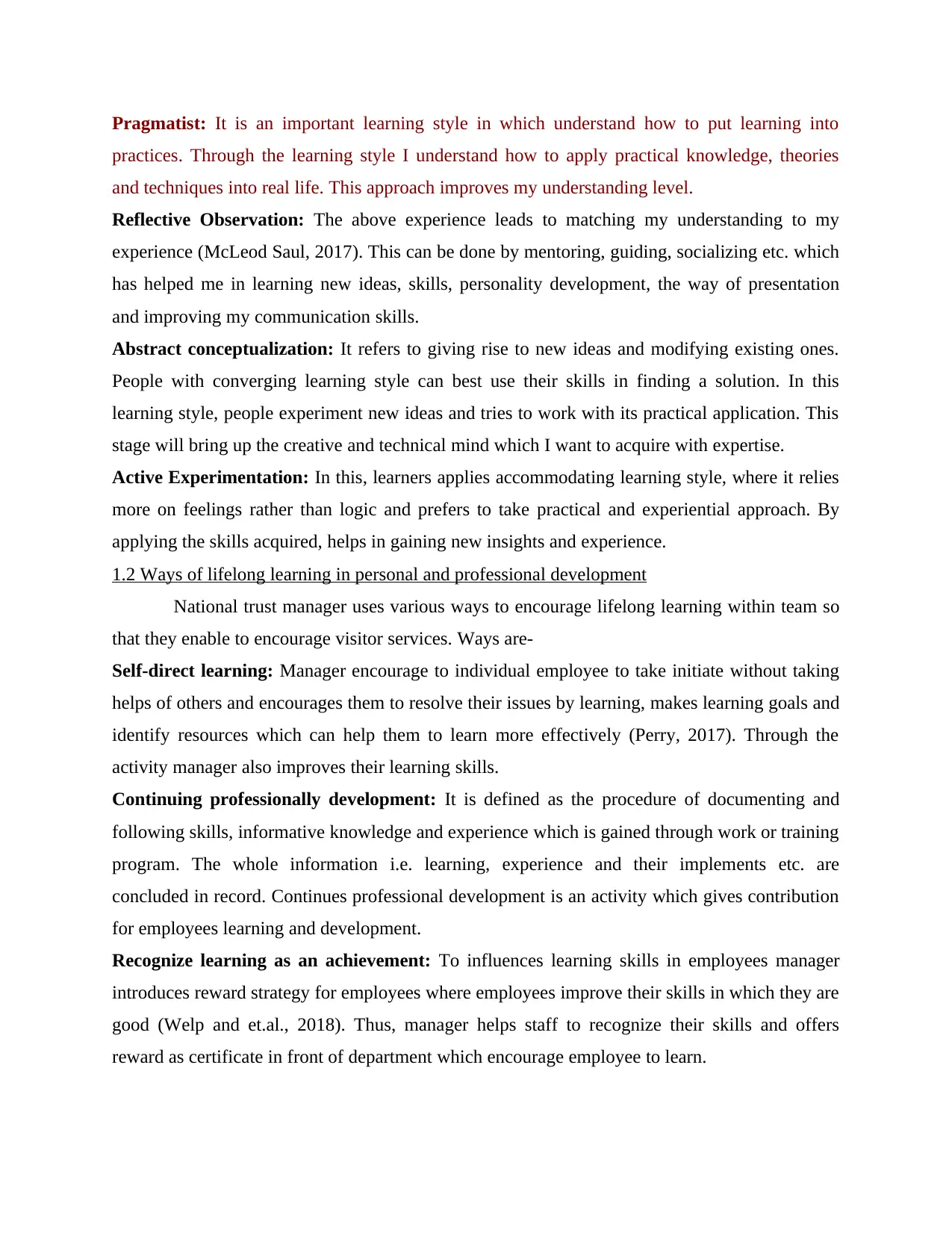
Pragmatist: It is an important learning style in which understand how to put learning into
practices. Through the learning style I understand how to apply practical knowledge, theories
and techniques into real life. This approach improves my understanding level.
Reflective Observation: The above experience leads to matching my understanding to my
experience (McLeod Saul, 2017). This can be done by mentoring, guiding, socializing etc. which
has helped me in learning new ideas, skills, personality development, the way of presentation
and improving my communication skills.
Abstract conceptualization: It refers to giving rise to new ideas and modifying existing ones.
People with converging learning style can best use their skills in finding a solution. In this
learning style, people experiment new ideas and tries to work with its practical application. This
stage will bring up the creative and technical mind which I want to acquire with expertise.
Active Experimentation: In this, learners applies accommodating learning style, where it relies
more on feelings rather than logic and prefers to take practical and experiential approach. By
applying the skills acquired, helps in gaining new insights and experience.
1.2 Ways of lifelong learning in personal and professional development
National trust manager uses various ways to encourage lifelong learning within team so
that they enable to encourage visitor services. Ways are-
Self-direct learning: Manager encourage to individual employee to take initiate without taking
helps of others and encourages them to resolve their issues by learning, makes learning goals and
identify resources which can help them to learn more effectively (Perry, 2017). Through the
activity manager also improves their learning skills.
Continuing professionally development: It is defined as the procedure of documenting and
following skills, informative knowledge and experience which is gained through work or training
program. The whole information i.e. learning, experience and their implements etc. are
concluded in record. Continues professional development is an activity which gives contribution
for employees learning and development.
Recognize learning as an achievement: To influences learning skills in employees manager
introduces reward strategy for employees where employees improve their skills in which they are
good (Welp and et.al., 2018). Thus, manager helps staff to recognize their skills and offers
reward as certificate in front of department which encourage employee to learn.
practices. Through the learning style I understand how to apply practical knowledge, theories
and techniques into real life. This approach improves my understanding level.
Reflective Observation: The above experience leads to matching my understanding to my
experience (McLeod Saul, 2017). This can be done by mentoring, guiding, socializing etc. which
has helped me in learning new ideas, skills, personality development, the way of presentation
and improving my communication skills.
Abstract conceptualization: It refers to giving rise to new ideas and modifying existing ones.
People with converging learning style can best use their skills in finding a solution. In this
learning style, people experiment new ideas and tries to work with its practical application. This
stage will bring up the creative and technical mind which I want to acquire with expertise.
Active Experimentation: In this, learners applies accommodating learning style, where it relies
more on feelings rather than logic and prefers to take practical and experiential approach. By
applying the skills acquired, helps in gaining new insights and experience.
1.2 Ways of lifelong learning in personal and professional development
National trust manager uses various ways to encourage lifelong learning within team so
that they enable to encourage visitor services. Ways are-
Self-direct learning: Manager encourage to individual employee to take initiate without taking
helps of others and encourages them to resolve their issues by learning, makes learning goals and
identify resources which can help them to learn more effectively (Perry, 2017). Through the
activity manager also improves their learning skills.
Continuing professionally development: It is defined as the procedure of documenting and
following skills, informative knowledge and experience which is gained through work or training
program. The whole information i.e. learning, experience and their implements etc. are
concluded in record. Continues professional development is an activity which gives contribution
for employees learning and development.
Recognize learning as an achievement: To influences learning skills in employees manager
introduces reward strategy for employees where employees improve their skills in which they are
good (Welp and et.al., 2018). Thus, manager helps staff to recognize their skills and offers
reward as certificate in front of department which encourage employee to learn.
Secure Best Marks with AI Grader
Need help grading? Try our AI Grader for instant feedback on your assignments.
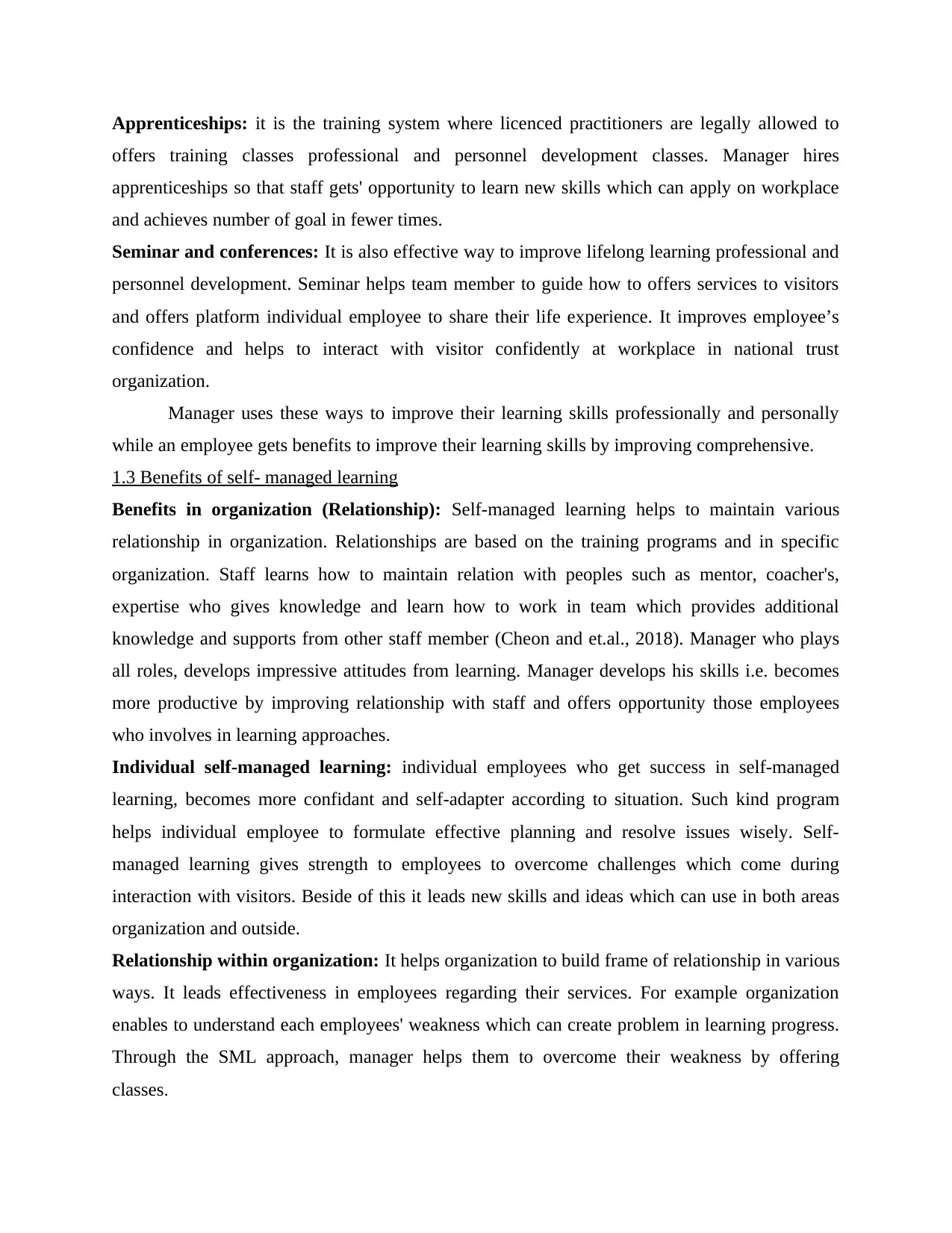
Apprenticeships: it is the training system where licenced practitioners are legally allowed to
offers training classes professional and personnel development classes. Manager hires
apprenticeships so that staff gets' opportunity to learn new skills which can apply on workplace
and achieves number of goal in fewer times.
Seminar and conferences: It is also effective way to improve lifelong learning professional and
personnel development. Seminar helps team member to guide how to offers services to visitors
and offers platform individual employee to share their life experience. It improves employee’s
confidence and helps to interact with visitor confidently at workplace in national trust
organization.
Manager uses these ways to improve their learning skills professionally and personally
while an employee gets benefits to improve their learning skills by improving comprehensive.
1.3 Benefits of self- managed learning
Benefits in organization (Relationship): Self-managed learning helps to maintain various
relationship in organization. Relationships are based on the training programs and in specific
organization. Staff learns how to maintain relation with peoples such as mentor, coacher's,
expertise who gives knowledge and learn how to work in team which provides additional
knowledge and supports from other staff member (Cheon and et.al., 2018). Manager who plays
all roles, develops impressive attitudes from learning. Manager develops his skills i.e. becomes
more productive by improving relationship with staff and offers opportunity those employees
who involves in learning approaches.
Individual self-managed learning: individual employees who get success in self-managed
learning, becomes more confidant and self-adapter according to situation. Such kind program
helps individual employee to formulate effective planning and resolve issues wisely. Self-
managed learning gives strength to employees to overcome challenges which come during
interaction with visitors. Beside of this it leads new skills and ideas which can use in both areas
organization and outside.
Relationship within organization: It helps organization to build frame of relationship in various
ways. It leads effectiveness in employees regarding their services. For example organization
enables to understand each employees' weakness which can create problem in learning progress.
Through the SML approach, manager helps them to overcome their weakness by offering
classes.
offers training classes professional and personnel development classes. Manager hires
apprenticeships so that staff gets' opportunity to learn new skills which can apply on workplace
and achieves number of goal in fewer times.
Seminar and conferences: It is also effective way to improve lifelong learning professional and
personnel development. Seminar helps team member to guide how to offers services to visitors
and offers platform individual employee to share their life experience. It improves employee’s
confidence and helps to interact with visitor confidently at workplace in national trust
organization.
Manager uses these ways to improve their learning skills professionally and personally
while an employee gets benefits to improve their learning skills by improving comprehensive.
1.3 Benefits of self- managed learning
Benefits in organization (Relationship): Self-managed learning helps to maintain various
relationship in organization. Relationships are based on the training programs and in specific
organization. Staff learns how to maintain relation with peoples such as mentor, coacher's,
expertise who gives knowledge and learn how to work in team which provides additional
knowledge and supports from other staff member (Cheon and et.al., 2018). Manager who plays
all roles, develops impressive attitudes from learning. Manager develops his skills i.e. becomes
more productive by improving relationship with staff and offers opportunity those employees
who involves in learning approaches.
Individual self-managed learning: individual employees who get success in self-managed
learning, becomes more confidant and self-adapter according to situation. Such kind program
helps individual employee to formulate effective planning and resolve issues wisely. Self-
managed learning gives strength to employees to overcome challenges which come during
interaction with visitors. Beside of this it leads new skills and ideas which can use in both areas
organization and outside.
Relationship within organization: It helps organization to build frame of relationship in various
ways. It leads effectiveness in employees regarding their services. For example organization
enables to understand each employees' weakness which can create problem in learning progress.
Through the SML approach, manager helps them to overcome their weakness by offering
classes.
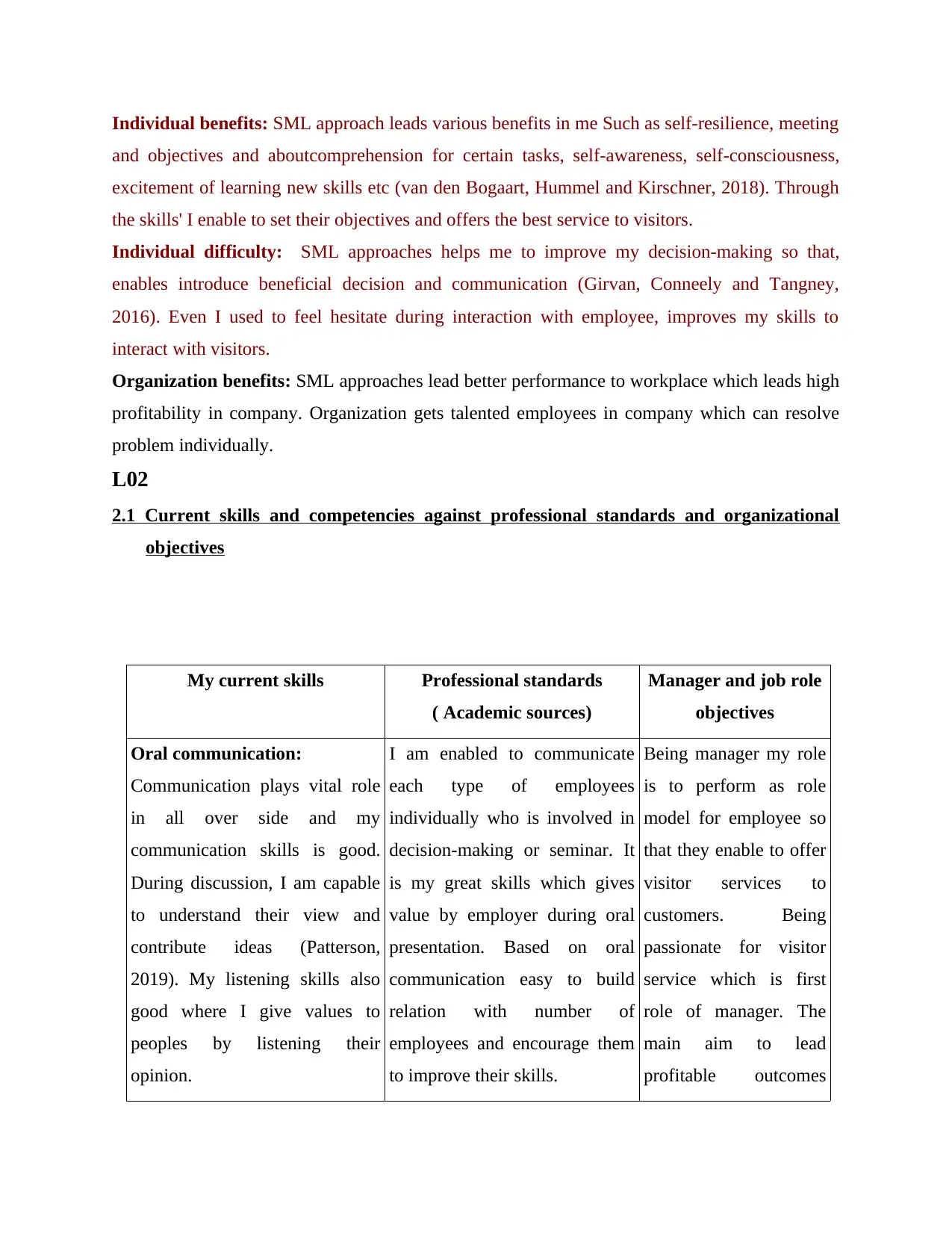
Individual benefits: SML approach leads various benefits in me Such as self-resilience, meeting
and objectives and aboutcomprehension for certain tasks, self-awareness, self-consciousness,
excitement of learning new skills etc (van den Bogaart, Hummel and Kirschner, 2018). Through
the skills' I enable to set their objectives and offers the best service to visitors.
Individual difficulty: SML approaches helps me to improve my decision-making so that,
enables introduce beneficial decision and communication (Girvan, Conneely and Tangney,
2016). Even I used to feel hesitate during interaction with employee, improves my skills to
interact with visitors.
Organization benefits: SML approaches lead better performance to workplace which leads high
profitability in company. Organization gets talented employees in company which can resolve
problem individually.
L02
2.1 Current skills and competencies against professional standards and organizational
objectives
My current skills Professional standards
( Academic sources)
Manager and job role
objectives
Oral communication:
Communication plays vital role
in all over side and my
communication skills is good.
During discussion, I am capable
to understand their view and
contribute ideas (Patterson,
2019). My listening skills also
good where I give values to
peoples by listening their
opinion.
I am enabled to communicate
each type of employees
individually who is involved in
decision-making or seminar. It
is my great skills which gives
value by employer during oral
presentation. Based on oral
communication easy to build
relation with number of
employees and encourage them
to improve their skills.
Being manager my role
is to perform as role
model for employee so
that they enable to offer
visitor services to
customers. Being
passionate for visitor
service which is first
role of manager. The
main aim to lead
profitable outcomes
and objectives and aboutcomprehension for certain tasks, self-awareness, self-consciousness,
excitement of learning new skills etc (van den Bogaart, Hummel and Kirschner, 2018). Through
the skills' I enable to set their objectives and offers the best service to visitors.
Individual difficulty: SML approaches helps me to improve my decision-making so that,
enables introduce beneficial decision and communication (Girvan, Conneely and Tangney,
2016). Even I used to feel hesitate during interaction with employee, improves my skills to
interact with visitors.
Organization benefits: SML approaches lead better performance to workplace which leads high
profitability in company. Organization gets talented employees in company which can resolve
problem individually.
L02
2.1 Current skills and competencies against professional standards and organizational
objectives
My current skills Professional standards
( Academic sources)
Manager and job role
objectives
Oral communication:
Communication plays vital role
in all over side and my
communication skills is good.
During discussion, I am capable
to understand their view and
contribute ideas (Patterson,
2019). My listening skills also
good where I give values to
peoples by listening their
opinion.
I am enabled to communicate
each type of employees
individually who is involved in
decision-making or seminar. It
is my great skills which gives
value by employer during oral
presentation. Based on oral
communication easy to build
relation with number of
employees and encourage them
to improve their skills.
Being manager my role
is to perform as role
model for employee so
that they enable to offer
visitor services to
customers. Being
passionate for visitor
service which is first
role of manager. The
main aim to lead
profitable outcomes
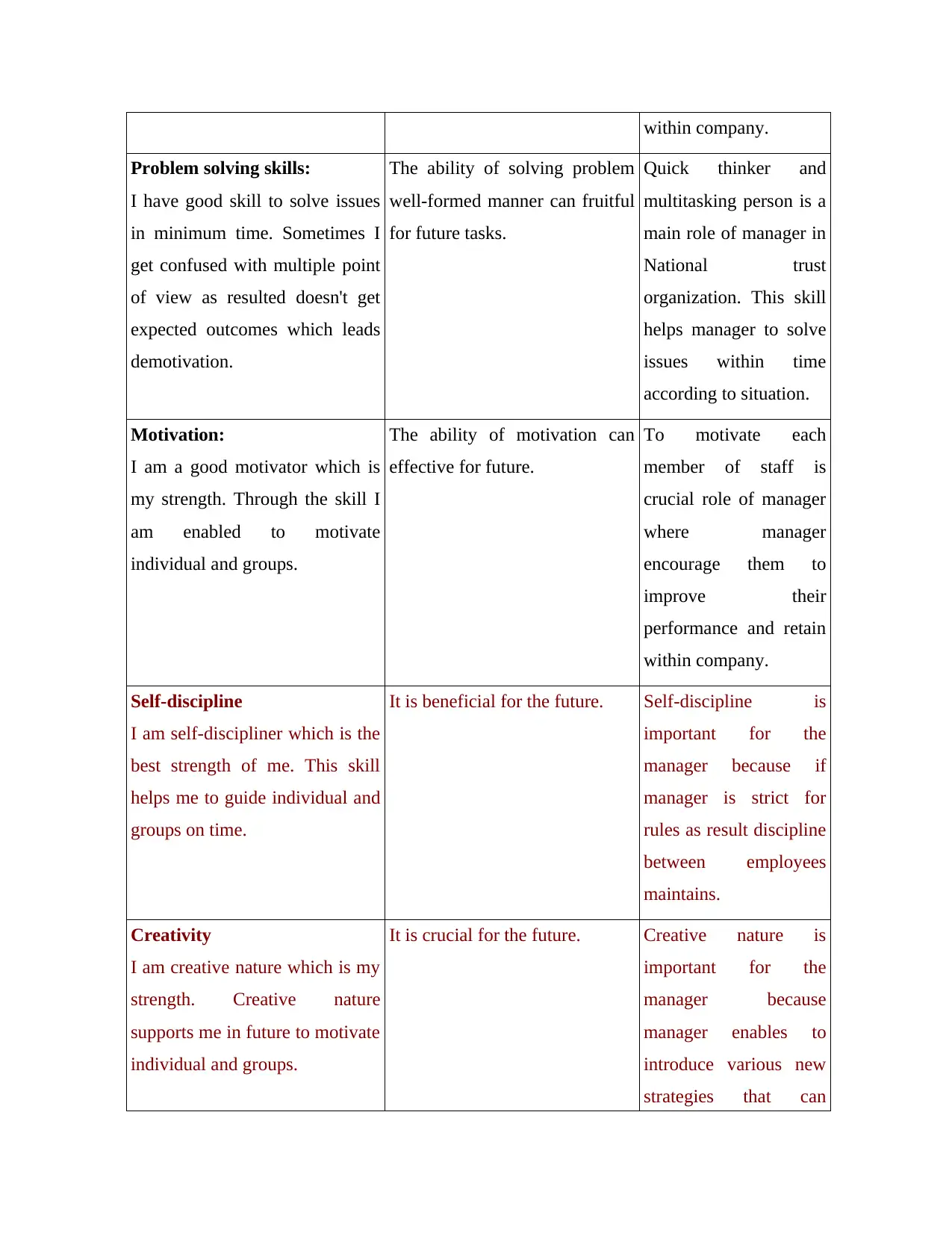
within company.
Problem solving skills:
I have good skill to solve issues
in minimum time. Sometimes I
get confused with multiple point
of view as resulted doesn't get
expected outcomes which leads
demotivation.
The ability of solving problem
well-formed manner can fruitful
for future tasks.
Quick thinker and
multitasking person is a
main role of manager in
National trust
organization. This skill
helps manager to solve
issues within time
according to situation.
Motivation:
I am a good motivator which is
my strength. Through the skill I
am enabled to motivate
individual and groups.
The ability of motivation can
effective for future.
To motivate each
member of staff is
crucial role of manager
where manager
encourage them to
improve their
performance and retain
within company.
Self-discipline
I am self-discipliner which is the
best strength of me. This skill
helps me to guide individual and
groups on time.
It is beneficial for the future. Self-discipline is
important for the
manager because if
manager is strict for
rules as result discipline
between employees
maintains.
Creativity
I am creative nature which is my
strength. Creative nature
supports me in future to motivate
individual and groups.
It is crucial for the future. Creative nature is
important for the
manager because
manager enables to
introduce various new
strategies that can
Problem solving skills:
I have good skill to solve issues
in minimum time. Sometimes I
get confused with multiple point
of view as resulted doesn't get
expected outcomes which leads
demotivation.
The ability of solving problem
well-formed manner can fruitful
for future tasks.
Quick thinker and
multitasking person is a
main role of manager in
National trust
organization. This skill
helps manager to solve
issues within time
according to situation.
Motivation:
I am a good motivator which is
my strength. Through the skill I
am enabled to motivate
individual and groups.
The ability of motivation can
effective for future.
To motivate each
member of staff is
crucial role of manager
where manager
encourage them to
improve their
performance and retain
within company.
Self-discipline
I am self-discipliner which is the
best strength of me. This skill
helps me to guide individual and
groups on time.
It is beneficial for the future. Self-discipline is
important for the
manager because if
manager is strict for
rules as result discipline
between employees
maintains.
Creativity
I am creative nature which is my
strength. Creative nature
supports me in future to motivate
individual and groups.
It is crucial for the future. Creative nature is
important for the
manager because
manager enables to
introduce various new
strategies that can
Paraphrase This Document
Need a fresh take? Get an instant paraphrase of this document with our AI Paraphraser
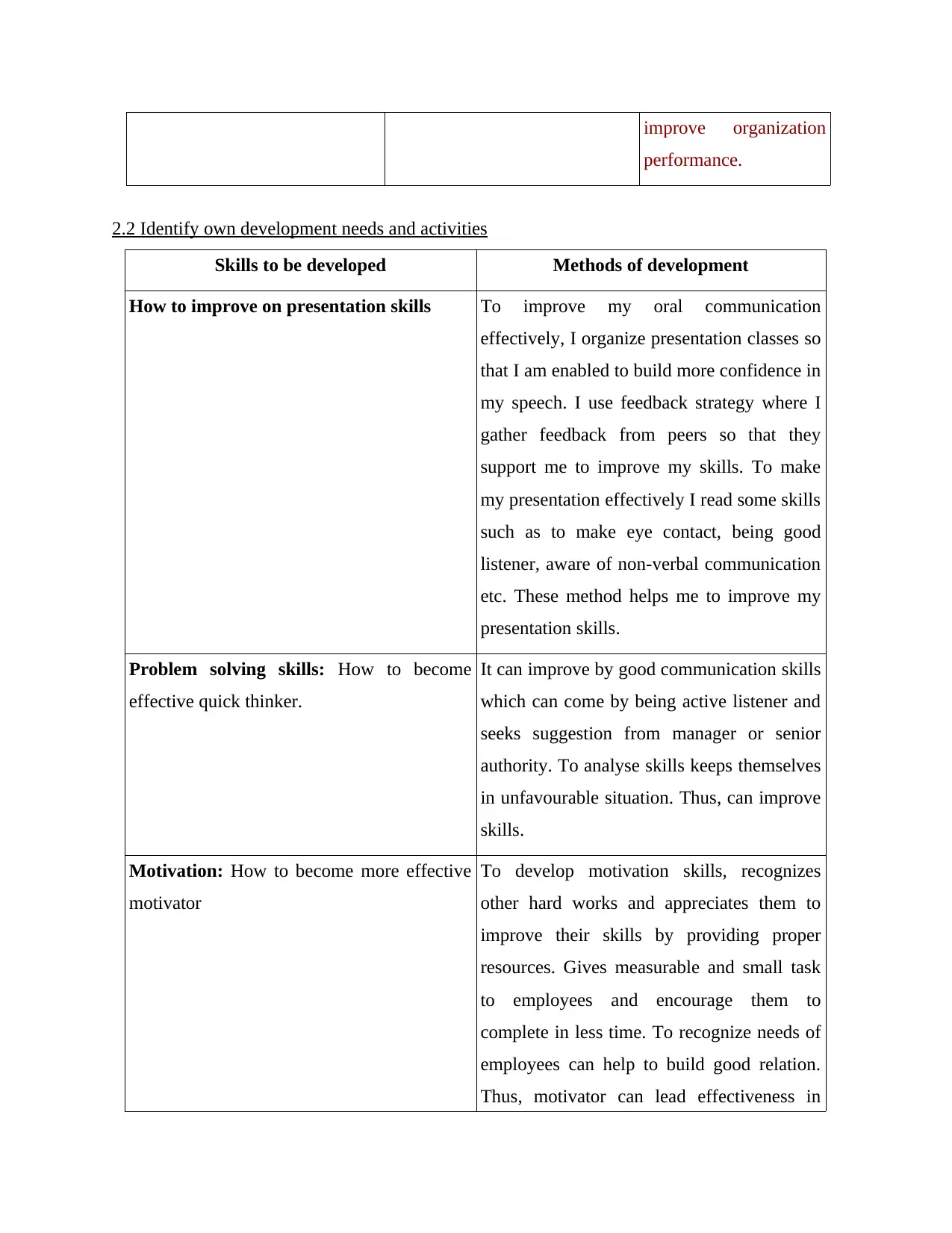
improve organization
performance.
2.2 Identify own development needs and activities
Skills to be developed Methods of development
How to improve on presentation skills To improve my oral communication
effectively, I organize presentation classes so
that I am enabled to build more confidence in
my speech. I use feedback strategy where I
gather feedback from peers so that they
support me to improve my skills. To make
my presentation effectively I read some skills
such as to make eye contact, being good
listener, aware of non-verbal communication
etc. These method helps me to improve my
presentation skills.
Problem solving skills: How to become
effective quick thinker.
It can improve by good communication skills
which can come by being active listener and
seeks suggestion from manager or senior
authority. To analyse skills keeps themselves
in unfavourable situation. Thus, can improve
skills.
Motivation: How to become more effective
motivator
To develop motivation skills, recognizes
other hard works and appreciates them to
improve their skills by providing proper
resources. Gives measurable and small task
to employees and encourage them to
complete in less time. To recognize needs of
employees can help to build good relation.
Thus, motivator can lead effectiveness in
performance.
2.2 Identify own development needs and activities
Skills to be developed Methods of development
How to improve on presentation skills To improve my oral communication
effectively, I organize presentation classes so
that I am enabled to build more confidence in
my speech. I use feedback strategy where I
gather feedback from peers so that they
support me to improve my skills. To make
my presentation effectively I read some skills
such as to make eye contact, being good
listener, aware of non-verbal communication
etc. These method helps me to improve my
presentation skills.
Problem solving skills: How to become
effective quick thinker.
It can improve by good communication skills
which can come by being active listener and
seeks suggestion from manager or senior
authority. To analyse skills keeps themselves
in unfavourable situation. Thus, can improve
skills.
Motivation: How to become more effective
motivator
To develop motivation skills, recognizes
other hard works and appreciates them to
improve their skills by providing proper
resources. Gives measurable and small task
to employees and encourage them to
complete in less time. To recognize needs of
employees can help to build good relation.
Thus, motivator can lead effectiveness in
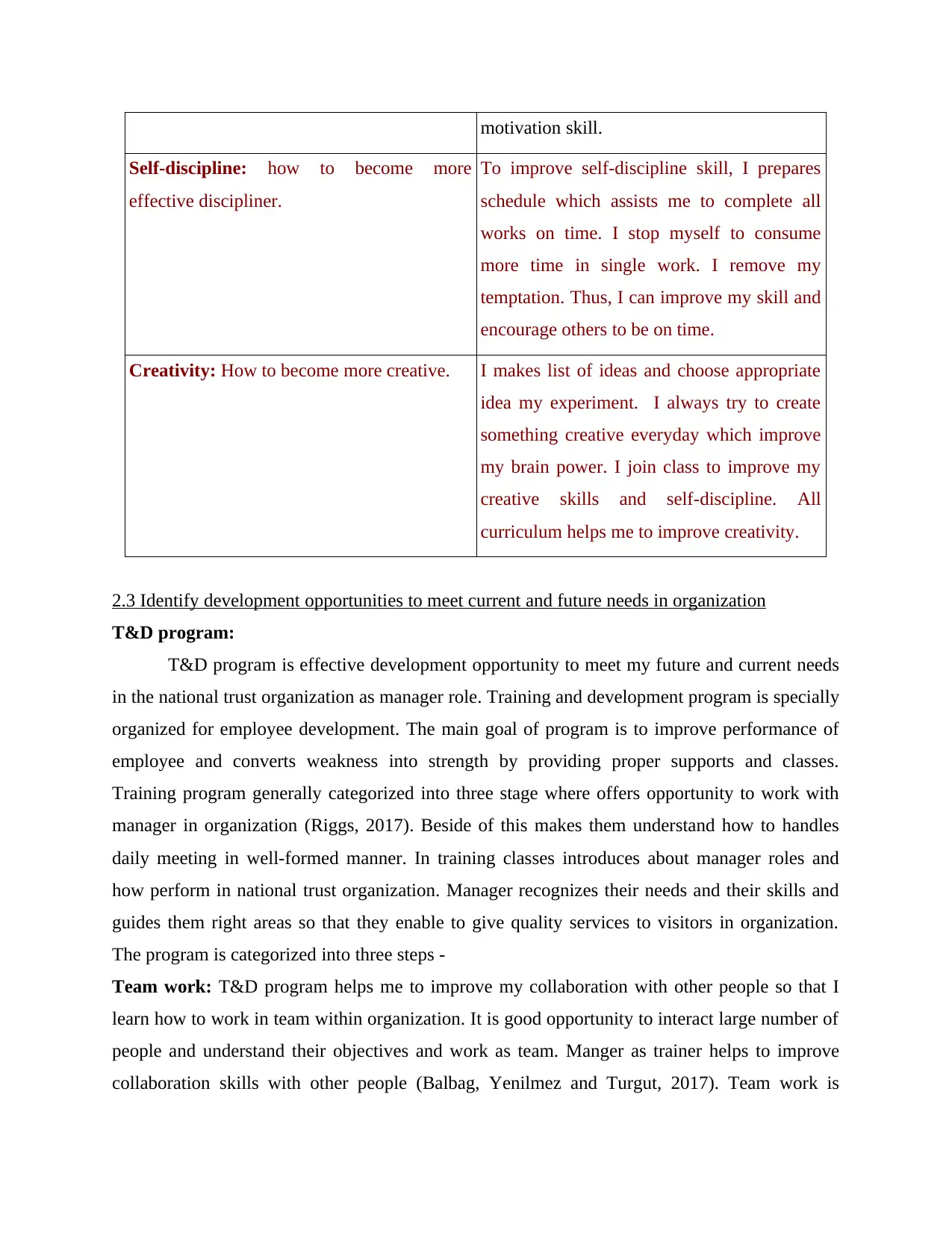
motivation skill.
Self-discipline: how to become more
effective discipliner.
To improve self-discipline skill, I prepares
schedule which assists me to complete all
works on time. I stop myself to consume
more time in single work. I remove my
temptation. Thus, I can improve my skill and
encourage others to be on time.
Creativity: How to become more creative. I makes list of ideas and choose appropriate
idea my experiment. I always try to create
something creative everyday which improve
my brain power. I join class to improve my
creative skills and self-discipline. All
curriculum helps me to improve creativity.
2.3 Identify development opportunities to meet current and future needs in organization
T&D program:
T&D program is effective development opportunity to meet my future and current needs
in the national trust organization as manager role. Training and development program is specially
organized for employee development. The main goal of program is to improve performance of
employee and converts weakness into strength by providing proper supports and classes.
Training program generally categorized into three stage where offers opportunity to work with
manager in organization (Riggs, 2017). Beside of this makes them understand how to handles
daily meeting in well-formed manner. In training classes introduces about manager roles and
how perform in national trust organization. Manager recognizes their needs and their skills and
guides them right areas so that they enable to give quality services to visitors in organization.
The program is categorized into three steps -
Team work: T&D program helps me to improve my collaboration with other people so that I
learn how to work in team within organization. It is good opportunity to interact large number of
people and understand their objectives and work as team. Manger as trainer helps to improve
collaboration skills with other people (Balbag, Yenilmez and Turgut, 2017). Team work is
Self-discipline: how to become more
effective discipliner.
To improve self-discipline skill, I prepares
schedule which assists me to complete all
works on time. I stop myself to consume
more time in single work. I remove my
temptation. Thus, I can improve my skill and
encourage others to be on time.
Creativity: How to become more creative. I makes list of ideas and choose appropriate
idea my experiment. I always try to create
something creative everyday which improve
my brain power. I join class to improve my
creative skills and self-discipline. All
curriculum helps me to improve creativity.
2.3 Identify development opportunities to meet current and future needs in organization
T&D program:
T&D program is effective development opportunity to meet my future and current needs
in the national trust organization as manager role. Training and development program is specially
organized for employee development. The main goal of program is to improve performance of
employee and converts weakness into strength by providing proper supports and classes.
Training program generally categorized into three stage where offers opportunity to work with
manager in organization (Riggs, 2017). Beside of this makes them understand how to handles
daily meeting in well-formed manner. In training classes introduces about manager roles and
how perform in national trust organization. Manager recognizes their needs and their skills and
guides them right areas so that they enable to give quality services to visitors in organization.
The program is categorized into three steps -
Team work: T&D program helps me to improve my collaboration with other people so that I
learn how to work in team within organization. It is good opportunity to interact large number of
people and understand their objectives and work as team. Manger as trainer helps to improve
collaboration skills with other people (Balbag, Yenilmez and Turgut, 2017). Team work is
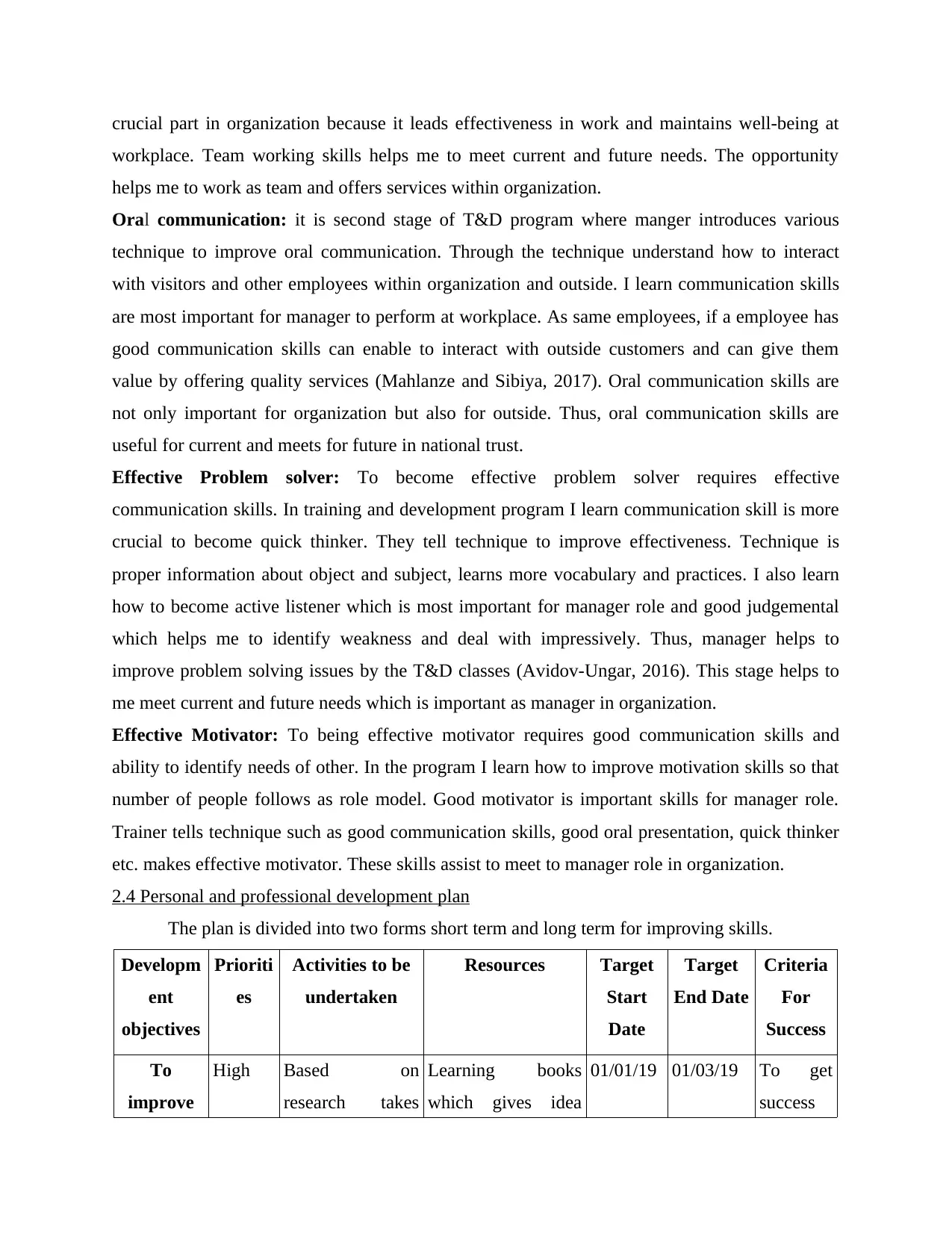
crucial part in organization because it leads effectiveness in work and maintains well-being at
workplace. Team working skills helps me to meet current and future needs. The opportunity
helps me to work as team and offers services within organization.
Oral communication: it is second stage of T&D program where manger introduces various
technique to improve oral communication. Through the technique understand how to interact
with visitors and other employees within organization and outside. I learn communication skills
are most important for manager to perform at workplace. As same employees, if a employee has
good communication skills can enable to interact with outside customers and can give them
value by offering quality services (Mahlanze and Sibiya, 2017). Oral communication skills are
not only important for organization but also for outside. Thus, oral communication skills are
useful for current and meets for future in national trust.
Effective Problem solver: To become effective problem solver requires effective
communication skills. In training and development program I learn communication skill is more
crucial to become quick thinker. They tell technique to improve effectiveness. Technique is
proper information about object and subject, learns more vocabulary and practices. I also learn
how to become active listener which is most important for manager role and good judgemental
which helps me to identify weakness and deal with impressively. Thus, manager helps to
improve problem solving issues by the T&D classes (Avidov-Ungar, 2016). This stage helps to
me meet current and future needs which is important as manager in organization.
Effective Motivator: To being effective motivator requires good communication skills and
ability to identify needs of other. In the program I learn how to improve motivation skills so that
number of people follows as role model. Good motivator is important skills for manager role.
Trainer tells technique such as good communication skills, good oral presentation, quick thinker
etc. makes effective motivator. These skills assist to meet to manager role in organization.
2.4 Personal and professional development plan
The plan is divided into two forms short term and long term for improving skills.
Developm
ent
objectives
Prioriti
es
Activities to be
undertaken
Resources Target
Start
Date
Target
End Date
Criteria
For
Success
To
improve
High Based on
research takes
Learning books
which gives idea
01/01/19 01/03/19 To get
success
workplace. Team working skills helps me to meet current and future needs. The opportunity
helps me to work as team and offers services within organization.
Oral communication: it is second stage of T&D program where manger introduces various
technique to improve oral communication. Through the technique understand how to interact
with visitors and other employees within organization and outside. I learn communication skills
are most important for manager to perform at workplace. As same employees, if a employee has
good communication skills can enable to interact with outside customers and can give them
value by offering quality services (Mahlanze and Sibiya, 2017). Oral communication skills are
not only important for organization but also for outside. Thus, oral communication skills are
useful for current and meets for future in national trust.
Effective Problem solver: To become effective problem solver requires effective
communication skills. In training and development program I learn communication skill is more
crucial to become quick thinker. They tell technique to improve effectiveness. Technique is
proper information about object and subject, learns more vocabulary and practices. I also learn
how to become active listener which is most important for manager role and good judgemental
which helps me to identify weakness and deal with impressively. Thus, manager helps to
improve problem solving issues by the T&D classes (Avidov-Ungar, 2016). This stage helps to
me meet current and future needs which is important as manager in organization.
Effective Motivator: To being effective motivator requires good communication skills and
ability to identify needs of other. In the program I learn how to improve motivation skills so that
number of people follows as role model. Good motivator is important skills for manager role.
Trainer tells technique such as good communication skills, good oral presentation, quick thinker
etc. makes effective motivator. These skills assist to meet to manager role in organization.
2.4 Personal and professional development plan
The plan is divided into two forms short term and long term for improving skills.
Developm
ent
objectives
Prioriti
es
Activities to be
undertaken
Resources Target
Start
Date
Target
End Date
Criteria
For
Success
To
improve
High Based on
research takes
Learning books
which gives idea
01/01/19 01/03/19 To get
success
Secure Best Marks with AI Grader
Need help grading? Try our AI Grader for instant feedback on your assignments.
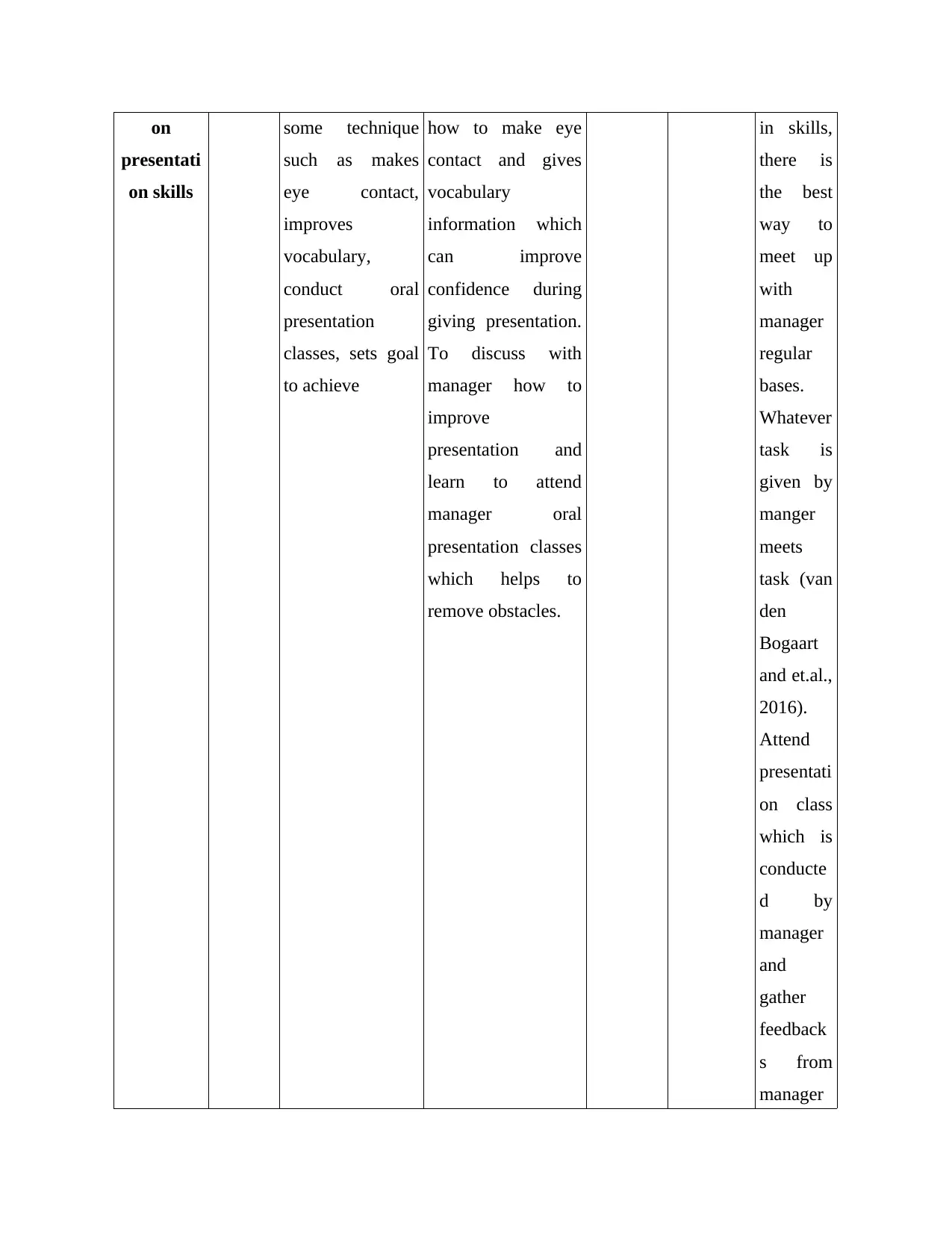
on
presentati
on skills
some technique
such as makes
eye contact,
improves
vocabulary,
conduct oral
presentation
classes, sets goal
to achieve
how to make eye
contact and gives
vocabulary
information which
can improve
confidence during
giving presentation.
To discuss with
manager how to
improve
presentation and
learn to attend
manager oral
presentation classes
which helps to
remove obstacles.
in skills,
there is
the best
way to
meet up
with
manager
regular
bases.
Whatever
task is
given by
manger
meets
task (van
den
Bogaart
and et.al.,
2016).
Attend
presentati
on class
which is
conducte
d by
manager
and
gather
feedback
s from
manager
presentati
on skills
some technique
such as makes
eye contact,
improves
vocabulary,
conduct oral
presentation
classes, sets goal
to achieve
how to make eye
contact and gives
vocabulary
information which
can improve
confidence during
giving presentation.
To discuss with
manager how to
improve
presentation and
learn to attend
manager oral
presentation classes
which helps to
remove obstacles.
in skills,
there is
the best
way to
meet up
with
manager
regular
bases.
Whatever
task is
given by
manger
meets
task (van
den
Bogaart
and et.al.,
2016).
Attend
presentati
on class
which is
conducte
d by
manager
and
gather
feedback
s from
manager
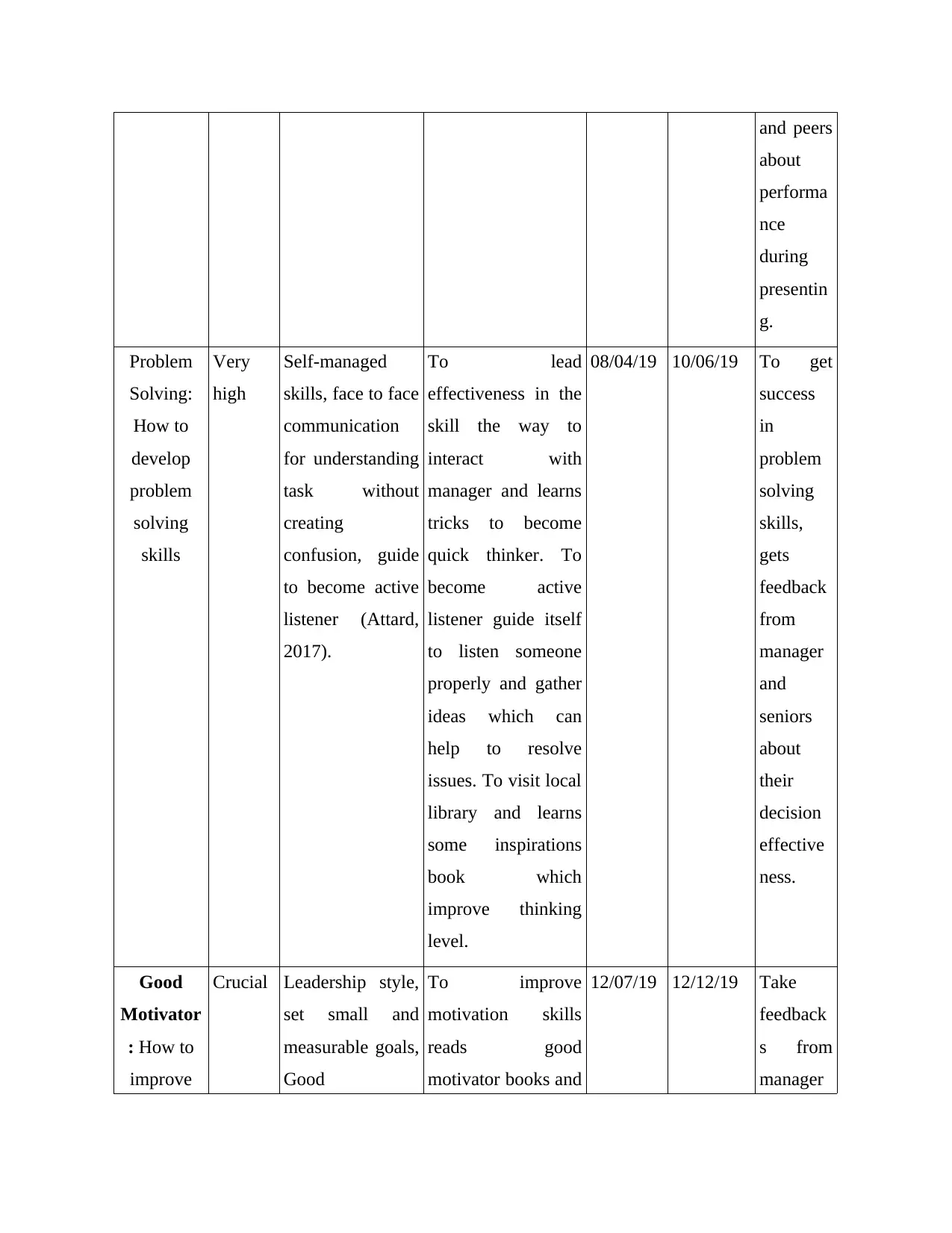
and peers
about
performa
nce
during
presentin
g.
Problem
Solving:
How to
develop
problem
solving
skills
Very
high
Self-managed
skills, face to face
communication
for understanding
task without
creating
confusion, guide
to become active
listener (Attard,
2017).
To lead
effectiveness in the
skill the way to
interact with
manager and learns
tricks to become
quick thinker. To
become active
listener guide itself
to listen someone
properly and gather
ideas which can
help to resolve
issues. To visit local
library and learns
some inspirations
book which
improve thinking
level.
08/04/19 10/06/19 To get
success
in
problem
solving
skills,
gets
feedback
from
manager
and
seniors
about
their
decision
effective
ness.
Good
Motivator
: How to
improve
Crucial Leadership style,
set small and
measurable goals,
Good
To improve
motivation skills
reads good
motivator books and
12/07/19 12/12/19 Take
feedback
s from
manager
about
performa
nce
during
presentin
g.
Problem
Solving:
How to
develop
problem
solving
skills
Very
high
Self-managed
skills, face to face
communication
for understanding
task without
creating
confusion, guide
to become active
listener (Attard,
2017).
To lead
effectiveness in the
skill the way to
interact with
manager and learns
tricks to become
quick thinker. To
become active
listener guide itself
to listen someone
properly and gather
ideas which can
help to resolve
issues. To visit local
library and learns
some inspirations
book which
improve thinking
level.
08/04/19 10/06/19 To get
success
in
problem
solving
skills,
gets
feedback
from
manager
and
seniors
about
their
decision
effective
ness.
Good
Motivator
: How to
improve
Crucial Leadership style,
set small and
measurable goals,
Good
To improve
motivation skills
reads good
motivator books and
12/07/19 12/12/19 Take
feedback
s from
manager
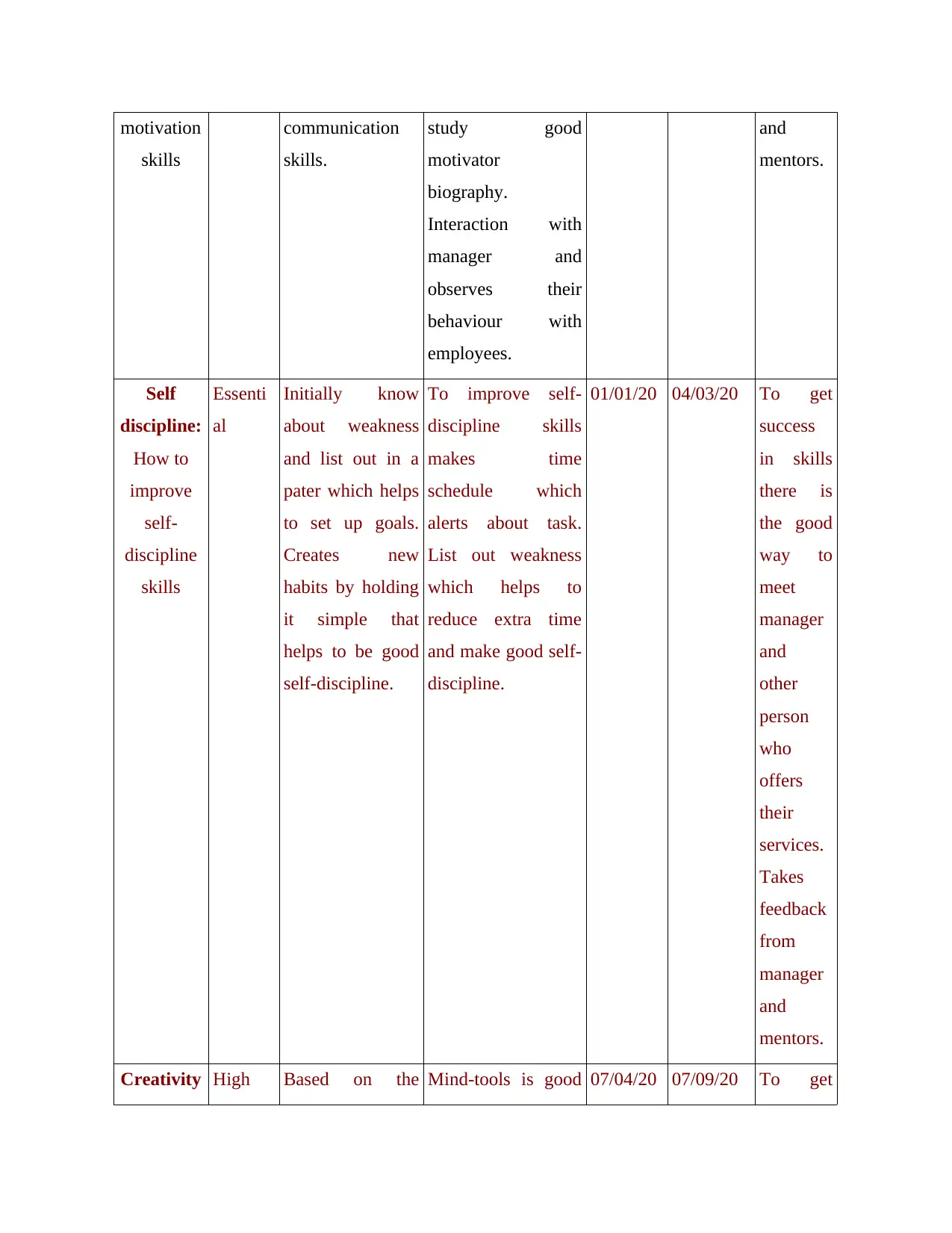
motivation
skills
communication
skills.
study good
motivator
biography.
Interaction with
manager and
observes their
behaviour with
employees.
and
mentors.
Self
discipline:
How to
improve
self-
discipline
skills
Essenti
al
Initially know
about weakness
and list out in a
pater which helps
to set up goals.
Creates new
habits by holding
it simple that
helps to be good
self-discipline.
To improve self-
discipline skills
makes time
schedule which
alerts about task.
List out weakness
which helps to
reduce extra time
and make good self-
discipline.
01/01/20 04/03/20 To get
success
in skills
there is
the good
way to
meet
manager
and
other
person
who
offers
their
services.
Takes
feedback
from
manager
and
mentors.
Creativity High Based on the Mind-tools is good 07/04/20 07/09/20 To get
skills
communication
skills.
study good
motivator
biography.
Interaction with
manager and
observes their
behaviour with
employees.
and
mentors.
Self
discipline:
How to
improve
self-
discipline
skills
Essenti
al
Initially know
about weakness
and list out in a
pater which helps
to set up goals.
Creates new
habits by holding
it simple that
helps to be good
self-discipline.
To improve self-
discipline skills
makes time
schedule which
alerts about task.
List out weakness
which helps to
reduce extra time
and make good self-
discipline.
01/01/20 04/03/20 To get
success
in skills
there is
the good
way to
meet
manager
and
other
person
who
offers
their
services.
Takes
feedback
from
manager
and
mentors.
Creativity High Based on the Mind-tools is good 07/04/20 07/09/20 To get
Paraphrase This Document
Need a fresh take? Get an instant paraphrase of this document with our AI Paraphraser
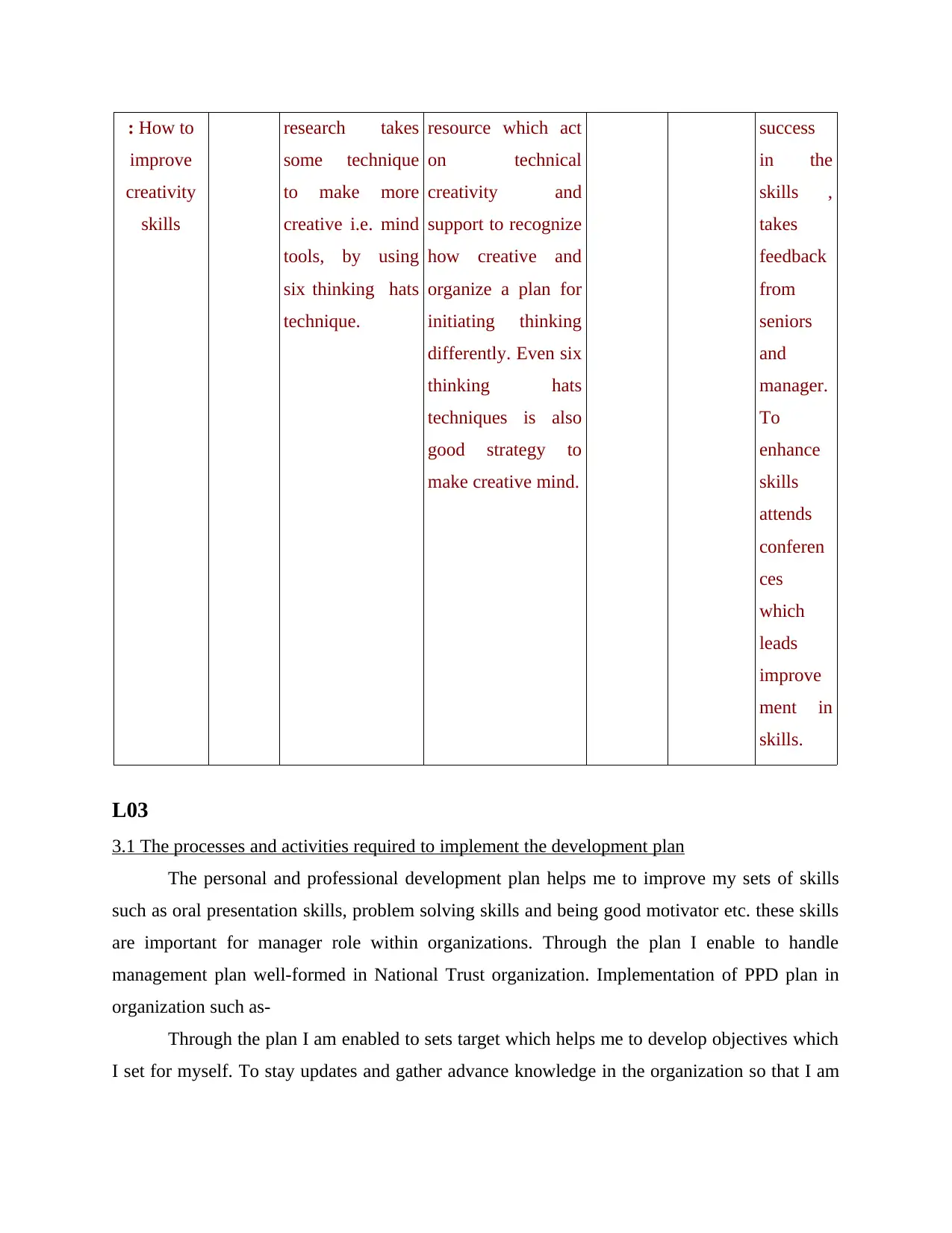
: How to
improve
creativity
skills
research takes
some technique
to make more
creative i.e. mind
tools, by using
six thinking hats
technique.
resource which act
on technical
creativity and
support to recognize
how creative and
organize a plan for
initiating thinking
differently. Even six
thinking hats
techniques is also
good strategy to
make creative mind.
success
in the
skills ,
takes
feedback
from
seniors
and
manager.
To
enhance
skills
attends
conferen
ces
which
leads
improve
ment in
skills.
L03
3.1 The processes and activities required to implement the development plan
The personal and professional development plan helps me to improve my sets of skills
such as oral presentation skills, problem solving skills and being good motivator etc. these skills
are important for manager role within organizations. Through the plan I enable to handle
management plan well-formed in National Trust organization. Implementation of PPD plan in
organization such as-
Through the plan I am enabled to sets target which helps me to develop objectives which
I set for myself. To stay updates and gather advance knowledge in the organization so that I am
improve
creativity
skills
research takes
some technique
to make more
creative i.e. mind
tools, by using
six thinking hats
technique.
resource which act
on technical
creativity and
support to recognize
how creative and
organize a plan for
initiating thinking
differently. Even six
thinking hats
techniques is also
good strategy to
make creative mind.
success
in the
skills ,
takes
feedback
from
seniors
and
manager.
To
enhance
skills
attends
conferen
ces
which
leads
improve
ment in
skills.
L03
3.1 The processes and activities required to implement the development plan
The personal and professional development plan helps me to improve my sets of skills
such as oral presentation skills, problem solving skills and being good motivator etc. these skills
are important for manager role within organizations. Through the plan I enable to handle
management plan well-formed in National Trust organization. Implementation of PPD plan in
organization such as-
Through the plan I am enabled to sets target which helps me to develop objectives which
I set for myself. To stay updates and gather advance knowledge in the organization so that I am
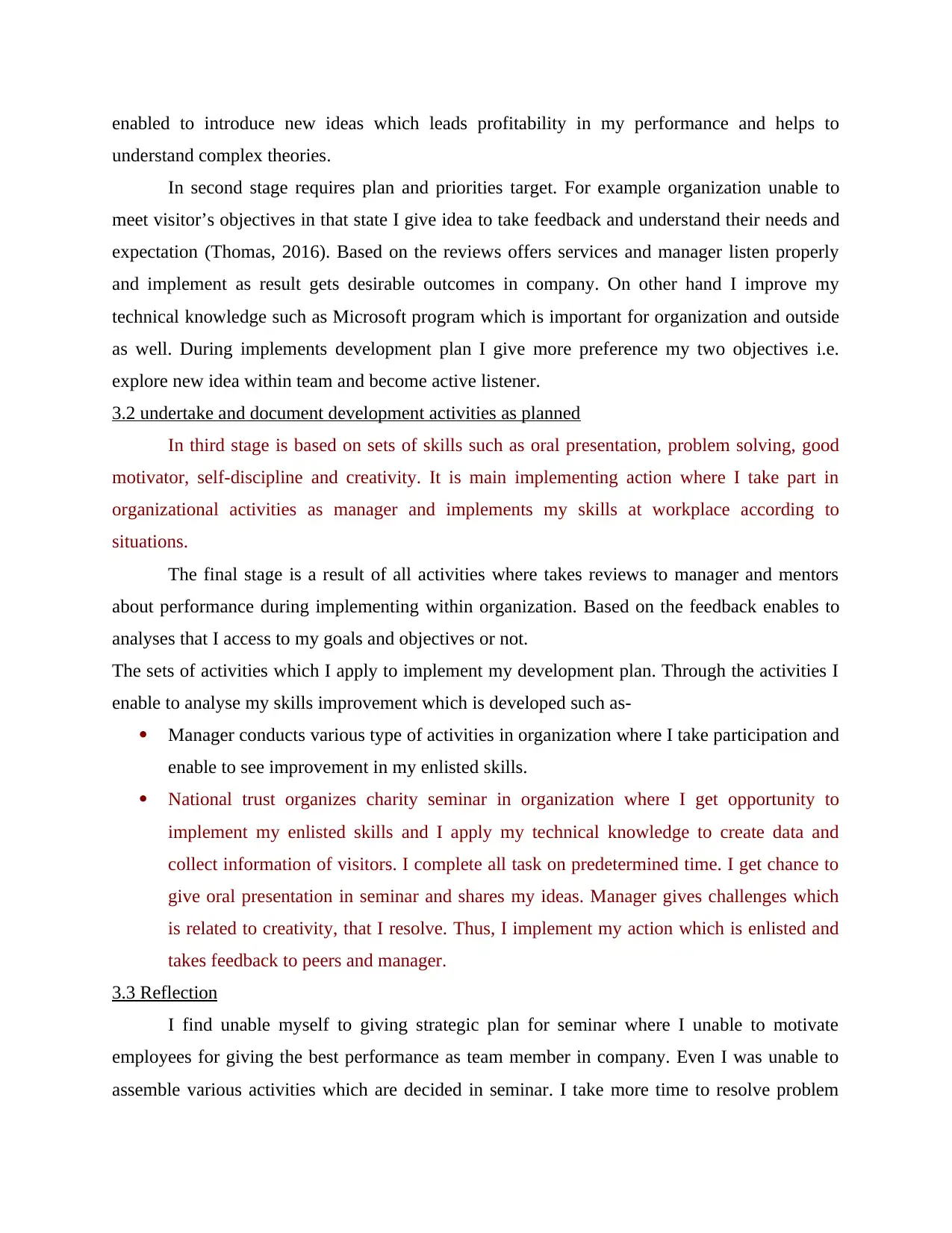
enabled to introduce new ideas which leads profitability in my performance and helps to
understand complex theories.
In second stage requires plan and priorities target. For example organization unable to
meet visitor’s objectives in that state I give idea to take feedback and understand their needs and
expectation (Thomas, 2016). Based on the reviews offers services and manager listen properly
and implement as result gets desirable outcomes in company. On other hand I improve my
technical knowledge such as Microsoft program which is important for organization and outside
as well. During implements development plan I give more preference my two objectives i.e.
explore new idea within team and become active listener.
3.2 undertake and document development activities as planned
In third stage is based on sets of skills such as oral presentation, problem solving, good
motivator, self-discipline and creativity. It is main implementing action where I take part in
organizational activities as manager and implements my skills at workplace according to
situations.
The final stage is a result of all activities where takes reviews to manager and mentors
about performance during implementing within organization. Based on the feedback enables to
analyses that I access to my goals and objectives or not.
The sets of activities which I apply to implement my development plan. Through the activities I
enable to analyse my skills improvement which is developed such as-
Manager conducts various type of activities in organization where I take participation and
enable to see improvement in my enlisted skills.
National trust organizes charity seminar in organization where I get opportunity to
implement my enlisted skills and I apply my technical knowledge to create data and
collect information of visitors. I complete all task on predetermined time. I get chance to
give oral presentation in seminar and shares my ideas. Manager gives challenges which
is related to creativity, that I resolve. Thus, I implement my action which is enlisted and
takes feedback to peers and manager.
3.3 Reflection
I find unable myself to giving strategic plan for seminar where I unable to motivate
employees for giving the best performance as team member in company. Even I was unable to
assemble various activities which are decided in seminar. I take more time to resolve problem
understand complex theories.
In second stage requires plan and priorities target. For example organization unable to
meet visitor’s objectives in that state I give idea to take feedback and understand their needs and
expectation (Thomas, 2016). Based on the reviews offers services and manager listen properly
and implement as result gets desirable outcomes in company. On other hand I improve my
technical knowledge such as Microsoft program which is important for organization and outside
as well. During implements development plan I give more preference my two objectives i.e.
explore new idea within team and become active listener.
3.2 undertake and document development activities as planned
In third stage is based on sets of skills such as oral presentation, problem solving, good
motivator, self-discipline and creativity. It is main implementing action where I take part in
organizational activities as manager and implements my skills at workplace according to
situations.
The final stage is a result of all activities where takes reviews to manager and mentors
about performance during implementing within organization. Based on the feedback enables to
analyses that I access to my goals and objectives or not.
The sets of activities which I apply to implement my development plan. Through the activities I
enable to analyse my skills improvement which is developed such as-
Manager conducts various type of activities in organization where I take participation and
enable to see improvement in my enlisted skills.
National trust organizes charity seminar in organization where I get opportunity to
implement my enlisted skills and I apply my technical knowledge to create data and
collect information of visitors. I complete all task on predetermined time. I get chance to
give oral presentation in seminar and shares my ideas. Manager gives challenges which
is related to creativity, that I resolve. Thus, I implement my action which is enlisted and
takes feedback to peers and manager.
3.3 Reflection
I find unable myself to giving strategic plan for seminar where I unable to motivate
employees for giving the best performance as team member in company. Even I was unable to
assemble various activities which are decided in seminar. I take more time to resolve problem
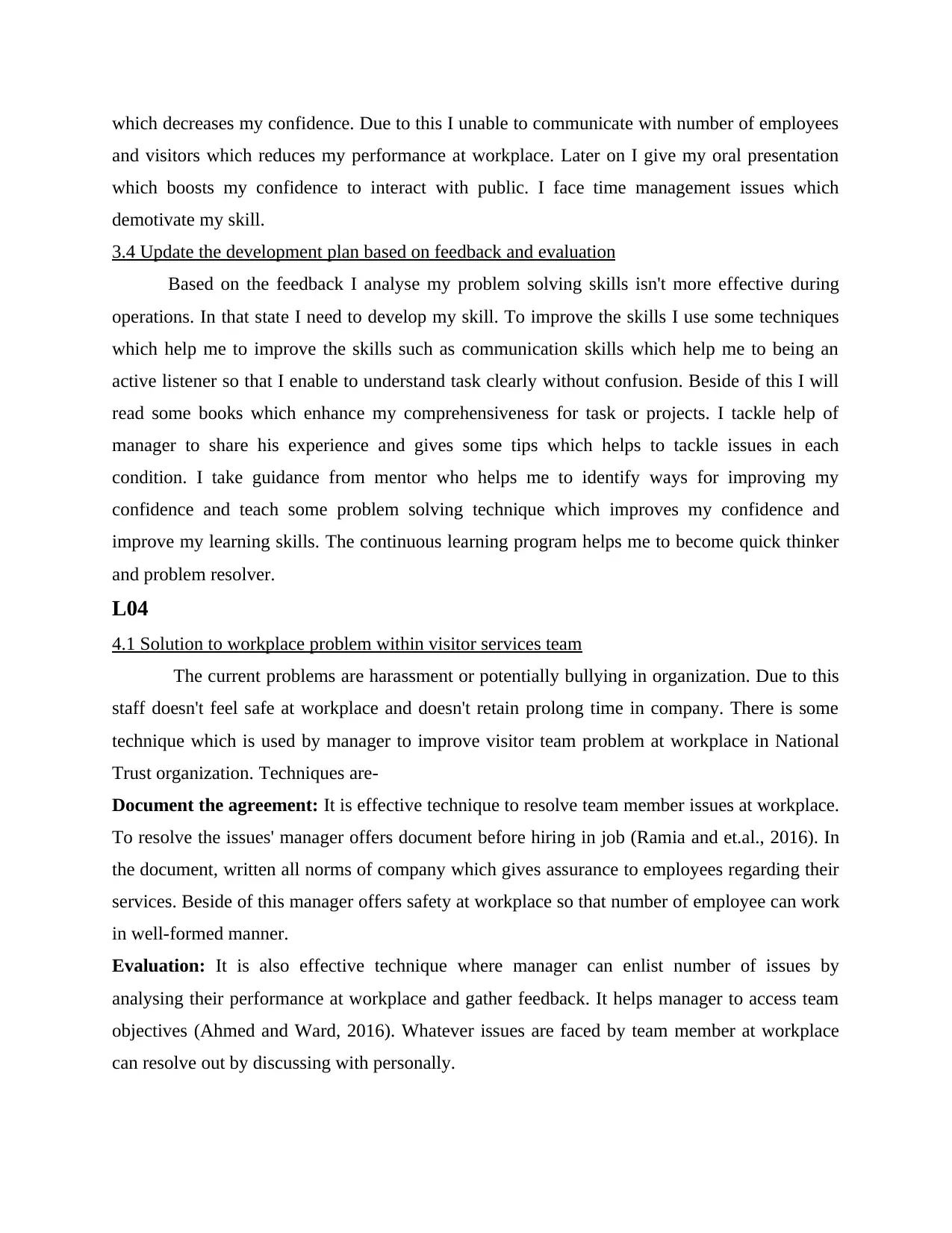
which decreases my confidence. Due to this I unable to communicate with number of employees
and visitors which reduces my performance at workplace. Later on I give my oral presentation
which boosts my confidence to interact with public. I face time management issues which
demotivate my skill.
3.4 Update the development plan based on feedback and evaluation
Based on the feedback I analyse my problem solving skills isn't more effective during
operations. In that state I need to develop my skill. To improve the skills I use some techniques
which help me to improve the skills such as communication skills which help me to being an
active listener so that I enable to understand task clearly without confusion. Beside of this I will
read some books which enhance my comprehensiveness for task or projects. I tackle help of
manager to share his experience and gives some tips which helps to tackle issues in each
condition. I take guidance from mentor who helps me to identify ways for improving my
confidence and teach some problem solving technique which improves my confidence and
improve my learning skills. The continuous learning program helps me to become quick thinker
and problem resolver.
L04
4.1 Solution to workplace problem within visitor services team
The current problems are harassment or potentially bullying in organization. Due to this
staff doesn't feel safe at workplace and doesn't retain prolong time in company. There is some
technique which is used by manager to improve visitor team problem at workplace in National
Trust organization. Techniques are-
Document the agreement: It is effective technique to resolve team member issues at workplace.
To resolve the issues' manager offers document before hiring in job (Ramia and et.al., 2016). In
the document, written all norms of company which gives assurance to employees regarding their
services. Beside of this manager offers safety at workplace so that number of employee can work
in well-formed manner.
Evaluation: It is also effective technique where manager can enlist number of issues by
analysing their performance at workplace and gather feedback. It helps manager to access team
objectives (Ahmed and Ward, 2016). Whatever issues are faced by team member at workplace
can resolve out by discussing with personally.
and visitors which reduces my performance at workplace. Later on I give my oral presentation
which boosts my confidence to interact with public. I face time management issues which
demotivate my skill.
3.4 Update the development plan based on feedback and evaluation
Based on the feedback I analyse my problem solving skills isn't more effective during
operations. In that state I need to develop my skill. To improve the skills I use some techniques
which help me to improve the skills such as communication skills which help me to being an
active listener so that I enable to understand task clearly without confusion. Beside of this I will
read some books which enhance my comprehensiveness for task or projects. I tackle help of
manager to share his experience and gives some tips which helps to tackle issues in each
condition. I take guidance from mentor who helps me to identify ways for improving my
confidence and teach some problem solving technique which improves my confidence and
improve my learning skills. The continuous learning program helps me to become quick thinker
and problem resolver.
L04
4.1 Solution to workplace problem within visitor services team
The current problems are harassment or potentially bullying in organization. Due to this
staff doesn't feel safe at workplace and doesn't retain prolong time in company. There is some
technique which is used by manager to improve visitor team problem at workplace in National
Trust organization. Techniques are-
Document the agreement: It is effective technique to resolve team member issues at workplace.
To resolve the issues' manager offers document before hiring in job (Ramia and et.al., 2016). In
the document, written all norms of company which gives assurance to employees regarding their
services. Beside of this manager offers safety at workplace so that number of employee can work
in well-formed manner.
Evaluation: It is also effective technique where manager can enlist number of issues by
analysing their performance at workplace and gather feedback. It helps manager to access team
objectives (Ahmed and Ward, 2016). Whatever issues are faced by team member at workplace
can resolve out by discussing with personally.
Secure Best Marks with AI Grader
Need help grading? Try our AI Grader for instant feedback on your assignments.
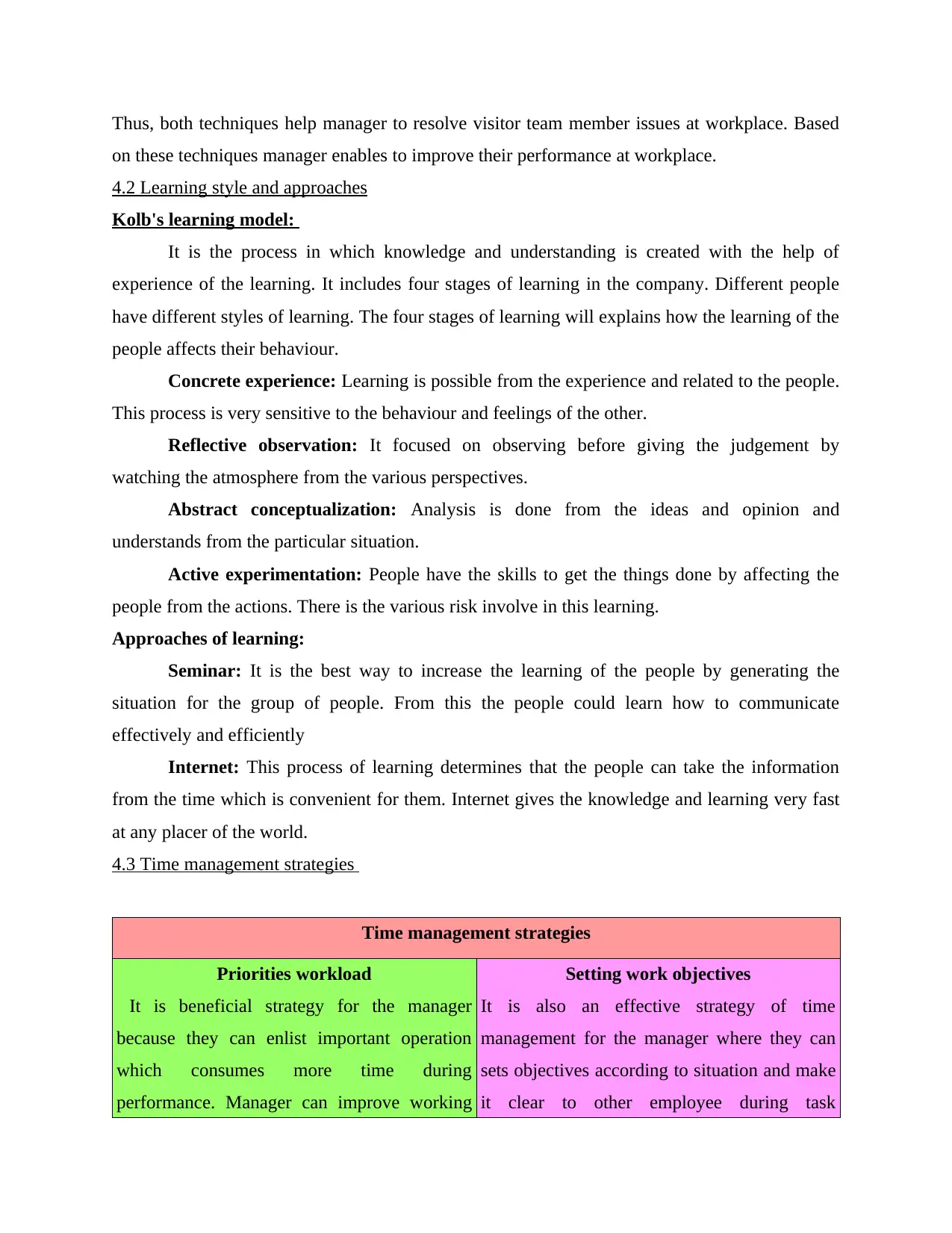
Thus, both techniques help manager to resolve visitor team member issues at workplace. Based
on these techniques manager enables to improve their performance at workplace.
4.2 Learning style and approaches
Kolb's learning model:
It is the process in which knowledge and understanding is created with the help of
experience of the learning. It includes four stages of learning in the company. Different people
have different styles of learning. The four stages of learning will explains how the learning of the
people affects their behaviour.
Concrete experience: Learning is possible from the experience and related to the people.
This process is very sensitive to the behaviour and feelings of the other.
Reflective observation: It focused on observing before giving the judgement by
watching the atmosphere from the various perspectives.
Abstract conceptualization: Analysis is done from the ideas and opinion and
understands from the particular situation.
Active experimentation: People have the skills to get the things done by affecting the
people from the actions. There is the various risk involve in this learning.
Approaches of learning:
Seminar: It is the best way to increase the learning of the people by generating the
situation for the group of people. From this the people could learn how to communicate
effectively and efficiently
Internet: This process of learning determines that the people can take the information
from the time which is convenient for them. Internet gives the knowledge and learning very fast
at any placer of the world.
4.3 Time management strategies
Time management strategies
Priorities workload
It is beneficial strategy for the manager
because they can enlist important operation
which consumes more time during
performance. Manager can improve working
Setting work objectives
It is also an effective strategy of time
management for the manager where they can
sets objectives according to situation and make
it clear to other employee during task
on these techniques manager enables to improve their performance at workplace.
4.2 Learning style and approaches
Kolb's learning model:
It is the process in which knowledge and understanding is created with the help of
experience of the learning. It includes four stages of learning in the company. Different people
have different styles of learning. The four stages of learning will explains how the learning of the
people affects their behaviour.
Concrete experience: Learning is possible from the experience and related to the people.
This process is very sensitive to the behaviour and feelings of the other.
Reflective observation: It focused on observing before giving the judgement by
watching the atmosphere from the various perspectives.
Abstract conceptualization: Analysis is done from the ideas and opinion and
understands from the particular situation.
Active experimentation: People have the skills to get the things done by affecting the
people from the actions. There is the various risk involve in this learning.
Approaches of learning:
Seminar: It is the best way to increase the learning of the people by generating the
situation for the group of people. From this the people could learn how to communicate
effectively and efficiently
Internet: This process of learning determines that the people can take the information
from the time which is convenient for them. Internet gives the knowledge and learning very fast
at any placer of the world.
4.3 Time management strategies
Time management strategies
Priorities workload
It is beneficial strategy for the manager
because they can enlist important operation
which consumes more time during
performance. Manager can improve working
Setting work objectives
It is also an effective strategy of time
management for the manager where they can
sets objectives according to situation and make
it clear to other employee during task
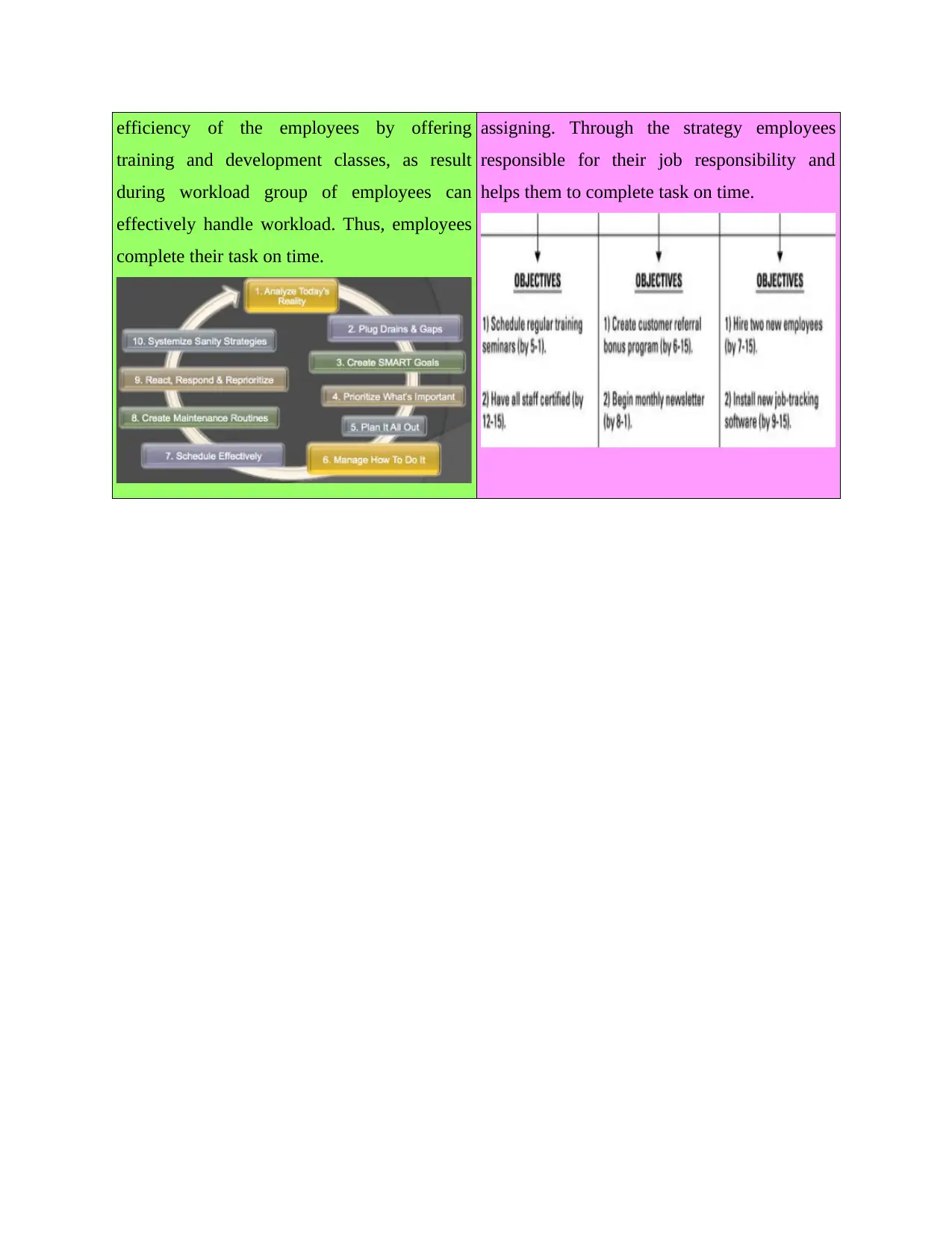
efficiency of the employees by offering
training and development classes, as result
during workload group of employees can
effectively handle workload. Thus, employees
complete their task on time.
assigning. Through the strategy employees
responsible for their job responsibility and
helps them to complete task on time.
training and development classes, as result
during workload group of employees can
effectively handle workload. Thus, employees
complete their task on time.
assigning. Through the strategy employees
responsible for their job responsibility and
helps them to complete task on time.
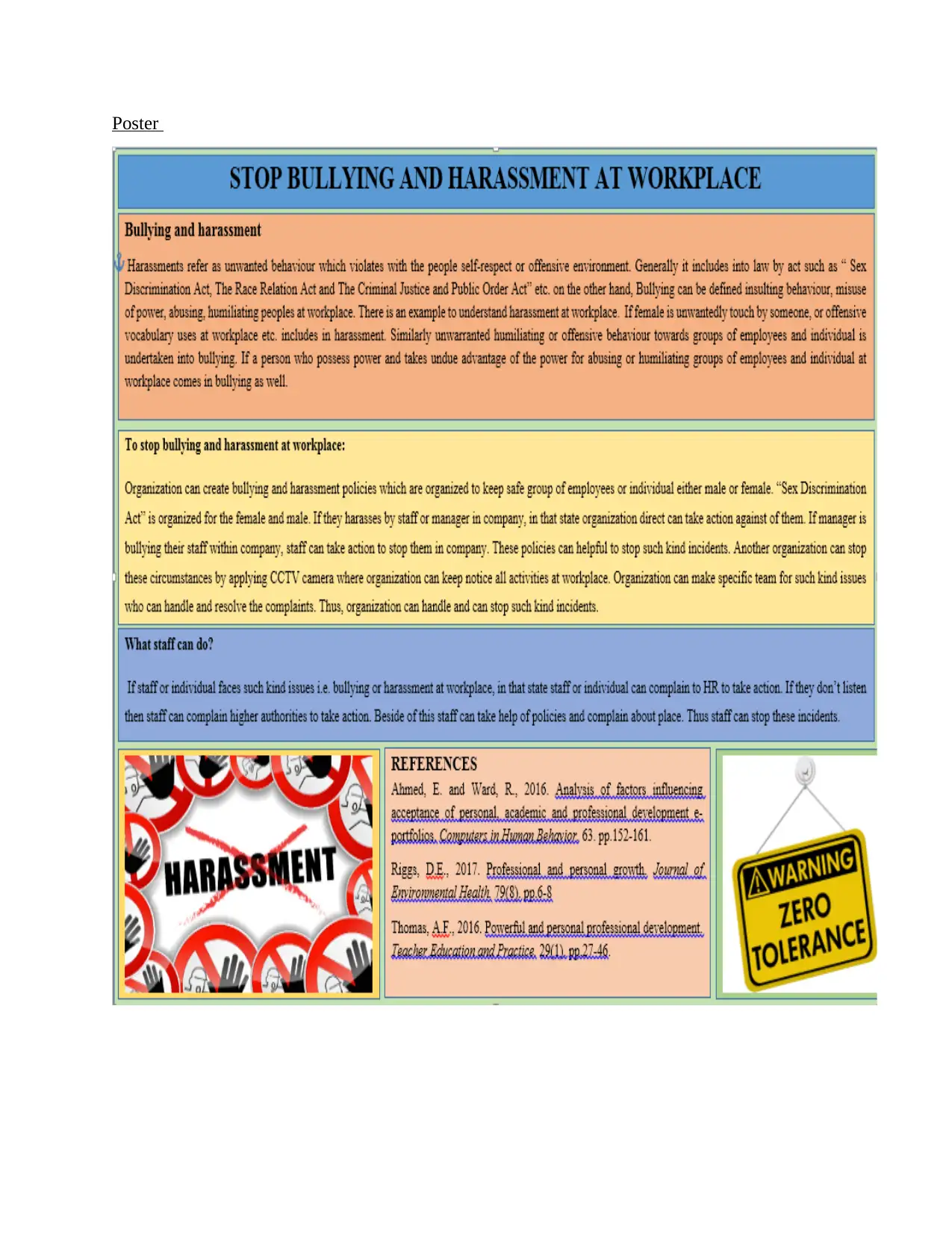
Poster
Paraphrase This Document
Need a fresh take? Get an instant paraphrase of this document with our AI Paraphraser
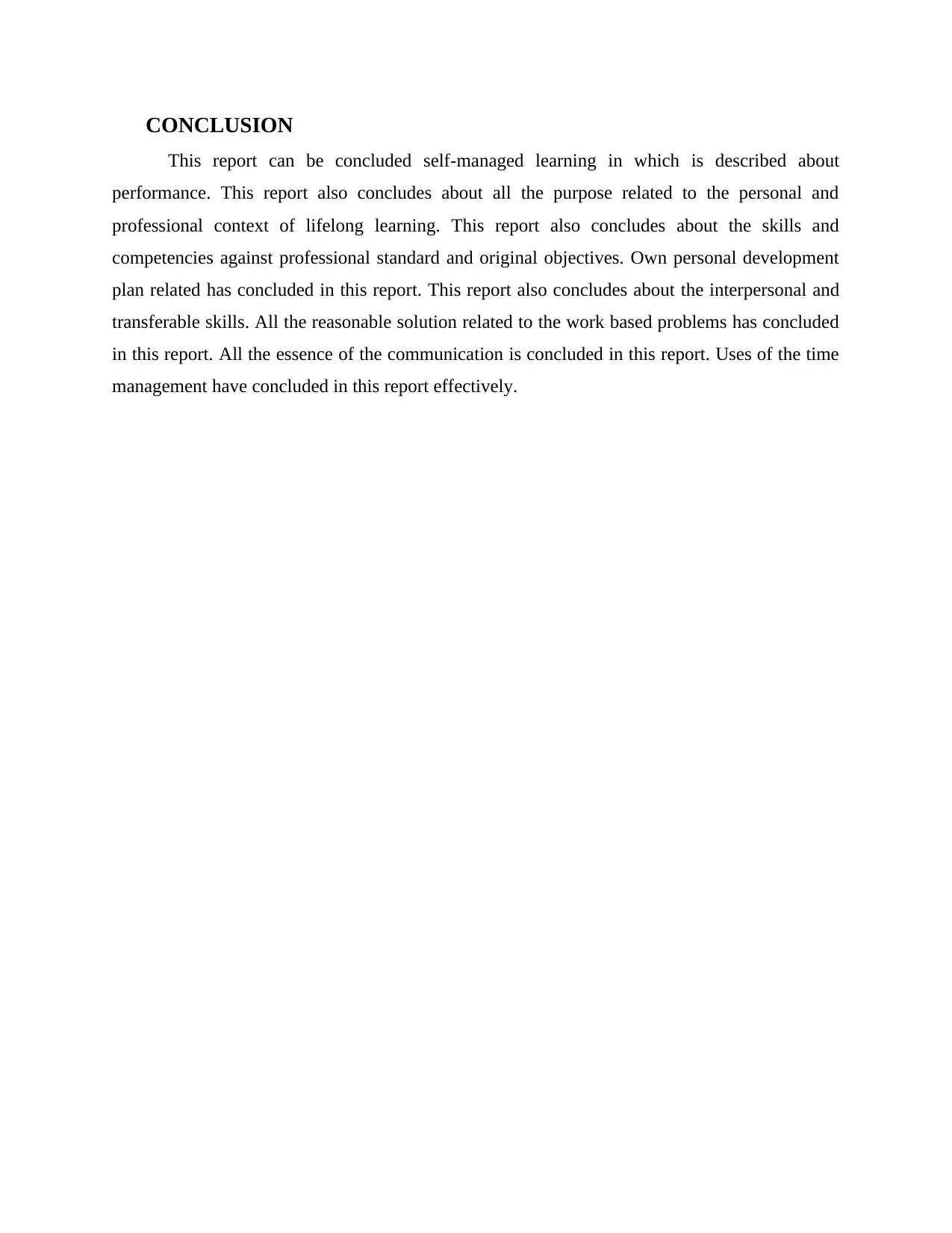
CONCLUSION
This report can be concluded self-managed learning in which is described about
performance. This report also concludes about all the purpose related to the personal and
professional context of lifelong learning. This report also concludes about the skills and
competencies against professional standard and original objectives. Own personal development
plan related has concluded in this report. This report also concludes about the interpersonal and
transferable skills. All the reasonable solution related to the work based problems has concluded
in this report. All the essence of the communication is concluded in this report. Uses of the time
management have concluded in this report effectively.
This report can be concluded self-managed learning in which is described about
performance. This report also concludes about all the purpose related to the personal and
professional context of lifelong learning. This report also concludes about the skills and
competencies against professional standard and original objectives. Own personal development
plan related has concluded in this report. This report also concludes about the interpersonal and
transferable skills. All the reasonable solution related to the work based problems has concluded
in this report. All the essence of the communication is concluded in this report. Uses of the time
management have concluded in this report effectively.
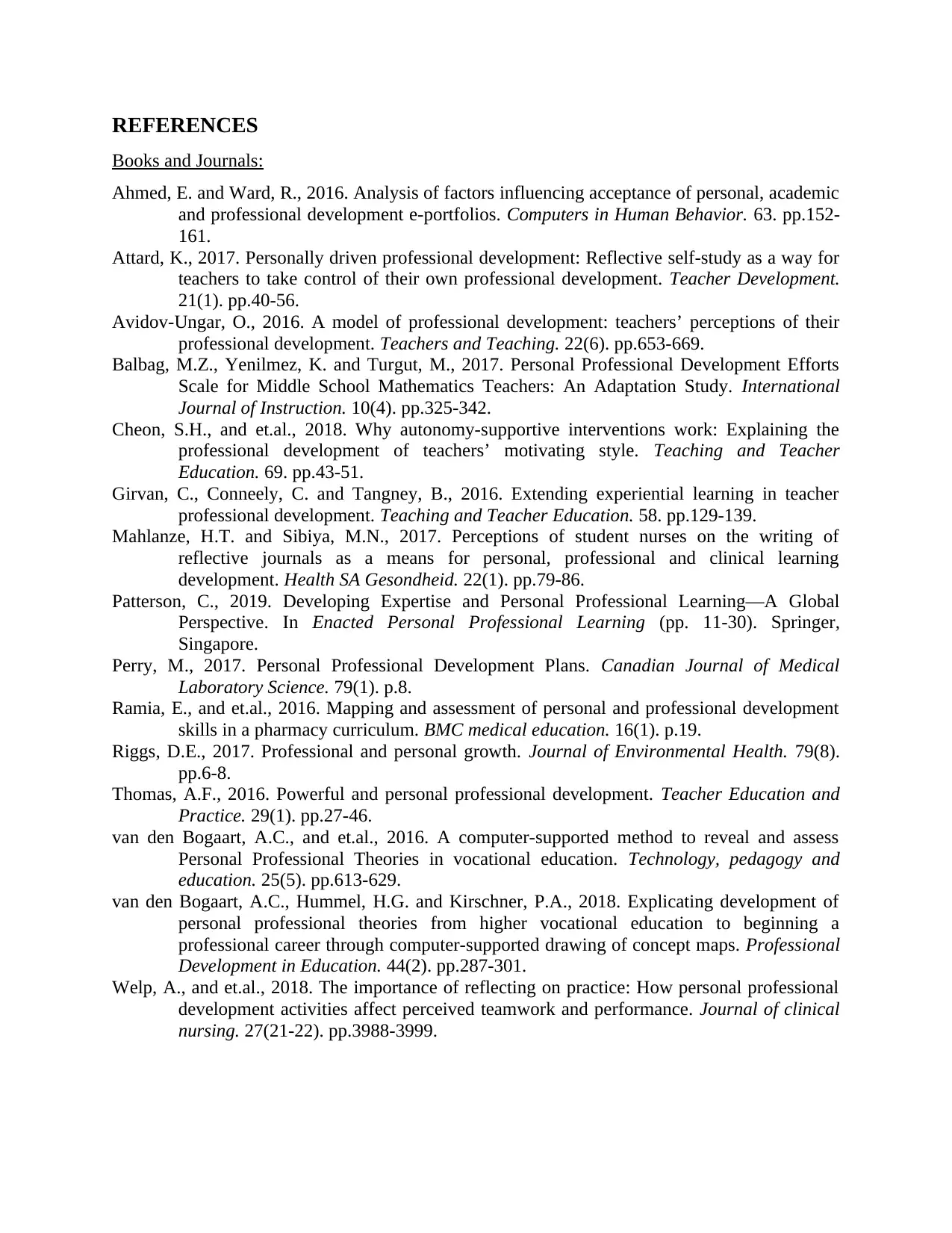
REFERENCES
Books and Journals:
Ahmed, E. and Ward, R., 2016. Analysis of factors influencing acceptance of personal, academic
and professional development e-portfolios. Computers in Human Behavior. 63. pp.152-
161.
Attard, K., 2017. Personally driven professional development: Reflective self-study as a way for
teachers to take control of their own professional development. Teacher Development.
21(1). pp.40-56.
Avidov-Ungar, O., 2016. A model of professional development: teachers’ perceptions of their
professional development. Teachers and Teaching. 22(6). pp.653-669.
Balbag, M.Z., Yenilmez, K. and Turgut, M., 2017. Personal Professional Development Efforts
Scale for Middle School Mathematics Teachers: An Adaptation Study. International
Journal of Instruction. 10(4). pp.325-342.
Cheon, S.H., and et.al., 2018. Why autonomy-supportive interventions work: Explaining the
professional development of teachers’ motivating style. Teaching and Teacher
Education. 69. pp.43-51.
Girvan, C., Conneely, C. and Tangney, B., 2016. Extending experiential learning in teacher
professional development. Teaching and Teacher Education. 58. pp.129-139.
Mahlanze, H.T. and Sibiya, M.N., 2017. Perceptions of student nurses on the writing of
reflective journals as a means for personal, professional and clinical learning
development. Health SA Gesondheid. 22(1). pp.79-86.
Patterson, C., 2019. Developing Expertise and Personal Professional Learning—A Global
Perspective. In Enacted Personal Professional Learning (pp. 11-30). Springer,
Singapore.
Perry, M., 2017. Personal Professional Development Plans. Canadian Journal of Medical
Laboratory Science. 79(1). p.8.
Ramia, E., and et.al., 2016. Mapping and assessment of personal and professional development
skills in a pharmacy curriculum. BMC medical education. 16(1). p.19.
Riggs, D.E., 2017. Professional and personal growth. Journal of Environmental Health. 79(8).
pp.6-8.
Thomas, A.F., 2016. Powerful and personal professional development. Teacher Education and
Practice. 29(1). pp.27-46.
van den Bogaart, A.C., and et.al., 2016. A computer-supported method to reveal and assess
Personal Professional Theories in vocational education. Technology, pedagogy and
education. 25(5). pp.613-629.
van den Bogaart, A.C., Hummel, H.G. and Kirschner, P.A., 2018. Explicating development of
personal professional theories from higher vocational education to beginning a
professional career through computer-supported drawing of concept maps. Professional
Development in Education. 44(2). pp.287-301.
Welp, A., and et.al., 2018. The importance of reflecting on practice: How personal professional
development activities affect perceived teamwork and performance. Journal of clinical
nursing. 27(21-22). pp.3988-3999.
Books and Journals:
Ahmed, E. and Ward, R., 2016. Analysis of factors influencing acceptance of personal, academic
and professional development e-portfolios. Computers in Human Behavior. 63. pp.152-
161.
Attard, K., 2017. Personally driven professional development: Reflective self-study as a way for
teachers to take control of their own professional development. Teacher Development.
21(1). pp.40-56.
Avidov-Ungar, O., 2016. A model of professional development: teachers’ perceptions of their
professional development. Teachers and Teaching. 22(6). pp.653-669.
Balbag, M.Z., Yenilmez, K. and Turgut, M., 2017. Personal Professional Development Efforts
Scale for Middle School Mathematics Teachers: An Adaptation Study. International
Journal of Instruction. 10(4). pp.325-342.
Cheon, S.H., and et.al., 2018. Why autonomy-supportive interventions work: Explaining the
professional development of teachers’ motivating style. Teaching and Teacher
Education. 69. pp.43-51.
Girvan, C., Conneely, C. and Tangney, B., 2016. Extending experiential learning in teacher
professional development. Teaching and Teacher Education. 58. pp.129-139.
Mahlanze, H.T. and Sibiya, M.N., 2017. Perceptions of student nurses on the writing of
reflective journals as a means for personal, professional and clinical learning
development. Health SA Gesondheid. 22(1). pp.79-86.
Patterson, C., 2019. Developing Expertise and Personal Professional Learning—A Global
Perspective. In Enacted Personal Professional Learning (pp. 11-30). Springer,
Singapore.
Perry, M., 2017. Personal Professional Development Plans. Canadian Journal of Medical
Laboratory Science. 79(1). p.8.
Ramia, E., and et.al., 2016. Mapping and assessment of personal and professional development
skills in a pharmacy curriculum. BMC medical education. 16(1). p.19.
Riggs, D.E., 2017. Professional and personal growth. Journal of Environmental Health. 79(8).
pp.6-8.
Thomas, A.F., 2016. Powerful and personal professional development. Teacher Education and
Practice. 29(1). pp.27-46.
van den Bogaart, A.C., and et.al., 2016. A computer-supported method to reveal and assess
Personal Professional Theories in vocational education. Technology, pedagogy and
education. 25(5). pp.613-629.
van den Bogaart, A.C., Hummel, H.G. and Kirschner, P.A., 2018. Explicating development of
personal professional theories from higher vocational education to beginning a
professional career through computer-supported drawing of concept maps. Professional
Development in Education. 44(2). pp.287-301.
Welp, A., and et.al., 2018. The importance of reflecting on practice: How personal professional
development activities affect perceived teamwork and performance. Journal of clinical
nursing. 27(21-22). pp.3988-3999.
1 out of 21
Related Documents
Your All-in-One AI-Powered Toolkit for Academic Success.
+13062052269
info@desklib.com
Available 24*7 on WhatsApp / Email
![[object Object]](/_next/static/media/star-bottom.7253800d.svg)
Unlock your academic potential
© 2024 | Zucol Services PVT LTD | All rights reserved.





